History books are full of people who have taken on extraordinary voyages, created unimaginable inventions, or fought for what matters the most. But what they often leave out are the animals that also had a significant influence on human history and culture. From Yorkie Smoky, who was credited as the first therapy dog while serving in WWII, to the actress Pepper the Cat, the pets that surround us shape the world we live in in the most precious and unlikely ways.
Below you’ll find many more historical pets from this Instagram account that made headlines and history with their exceptional stories. Scroll down to see them for yourself, so the paw prints they left on our past continue to live on!
#1
She could fit in a helmet — but her impact couldn’t be measured that way.
Smoky wasn’t bred for war. She wasn’t even trained for it. She was found in an abandoned foxhole in New Guinea, no bigger than a loaf of bread, her coat tangled and eyes wide. No one knew where she came from. But from that moment on, she belonged to the soldiers.
She didn’t look like much — four pounds, seven inches tall — but Smoky flew in combat planes. She parachuted with her handler. She comforted wounded men in field hospitals and entertained troops with tricks, bringing laughter into places where there was none.
But her greatest moment came in silence.
An airstrip was being built under fire, and communications cable had to be run through a narrow underground pipe — too small and dangerous for a person to enter. So they tied a string to Smoky’s collar, coaxed her in, and watched as she crawled through 70 feet of darkness, debris, and dust… and came out the other side with the line.
She saved them days of work. Maybe lives.
Smoky didn’t know about tactics or warfare. She only knew voices. Faces. The people who fed her, held her, and needed her.
And somehow, she understood enough to help.
That’s why I remember her. Because sometimes, the smallest one in the room changes everything. And because love — real love — doesn’t ask about size, rank, or species.
We haven’t forgotten you, Smoky. And we never should.
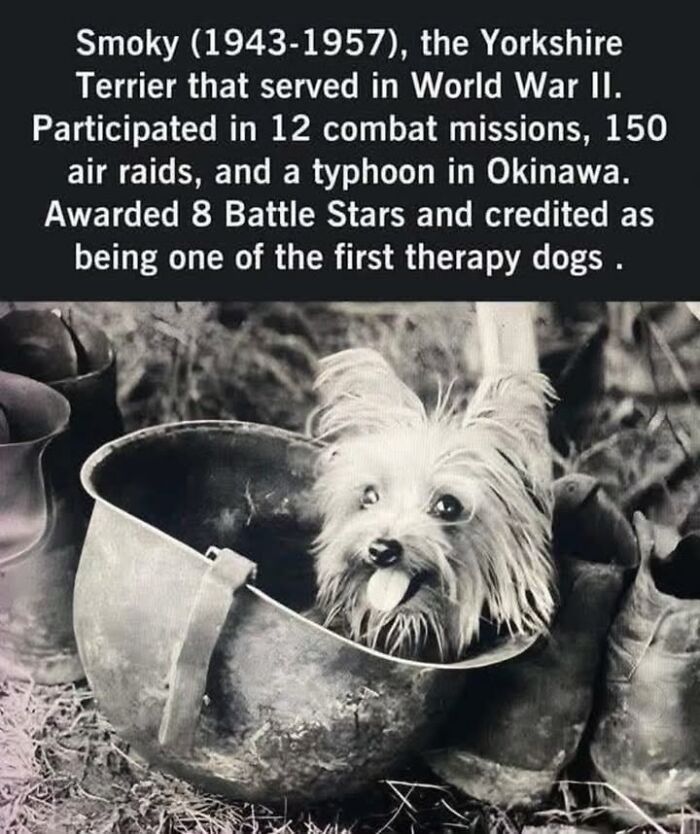
Image source: petshistorical
#2
Togo. Not the statue in Central Park. Not the name most people remember. But the dog who actually ran the farthest, braved the worst, and asked for nothing in return.
In 1925, a deadly outbreak threatened the children of Nome, Alaska. A relay of sled dogs carried the antitoxin across hundreds of frozen miles. Most know Balto. But Togo led the longest and most dangerous stretch — 260 miles through blizzards, cracking ice, and black Arctic night.
He was 12 years old. Too old, they said. Too small. Too spirited. But he didn’t flinch. He crossed the Norton Sound as the ice split beneath him. He slept little. He kept going.
When it was over, others met the cameras. Togo returned quietly with his musher, Leonhard Seppala. No medals. No parade. Just the satisfaction of having made it home.
Togo didn’t run for glory. He ran because he trusted. Because he knew the way — and chose to go farther.
I remember him because the world doesn’t always reward the right one. And because some heroes never ask to be seen.
We haven’t forgotten you, Togo. And we never should.
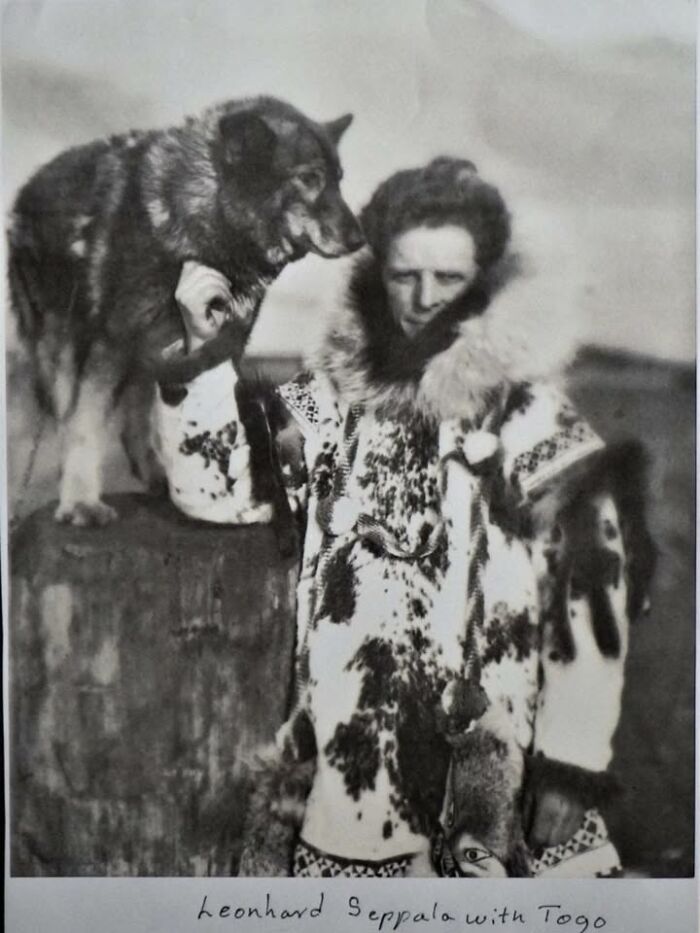
Image source: petshistorical
#3
Sometimes, the smallest figures leave the largest shadows.
Stubby wasn’t bred for war. He was a stray—just a short, stocky mutt with no pedigree and no orders. But he showed up on a training field in Connecticut, made friends with a soldier, and refused to leave.
When his unit shipped out to Europe, Stubby hid aboard the ship. By the time they landed in France, he was their mascot. By the time they returned home, he was a legend.
Stubby served in the trenches for 18 months. He survived gas attacks, artillery fire, and freezing nights. He learned to recognize the sound of incoming shells before the men could. He warned of gas before the whistles blew. He found wounded soldiers in no-man’s-land and stayed with them until help arrived.
One time, he even caught a German spy sneaking through the lines—by chasing him down and holding him by the seat of his pants until American troops arrived.
They gave him a uniform. A medal. A salute. But none of that ever really mattered to him. Stubby wasn’t following a flag or a cause. He followed people. The ones who fed him, trusted him, and fought beside him.
He was promoted to sergeant. But he never asked for rank.
I remember Stubby because some of the greatest acts of courage come from those who never intended to be brave. He didn’t go to war for glory. He went because someone he loved did.
We haven’t forgotten you, Stubby. And we never should.
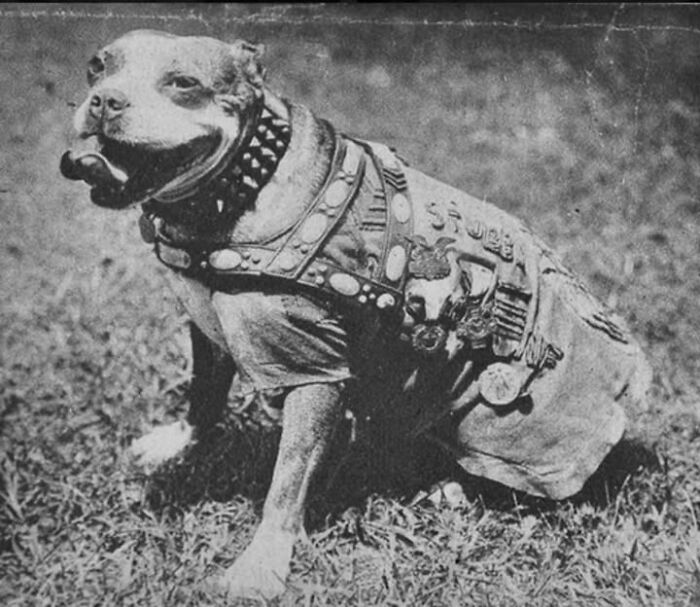
Image source: petshistorical
#4
“You, sweet Patrice, were in the habit of joining us at table and fawningly asking for food in our lap, you were accustomed to lick with your gready tongue the cup which my hands often held for you and regularly to welcome your tired master with wagging tail..”
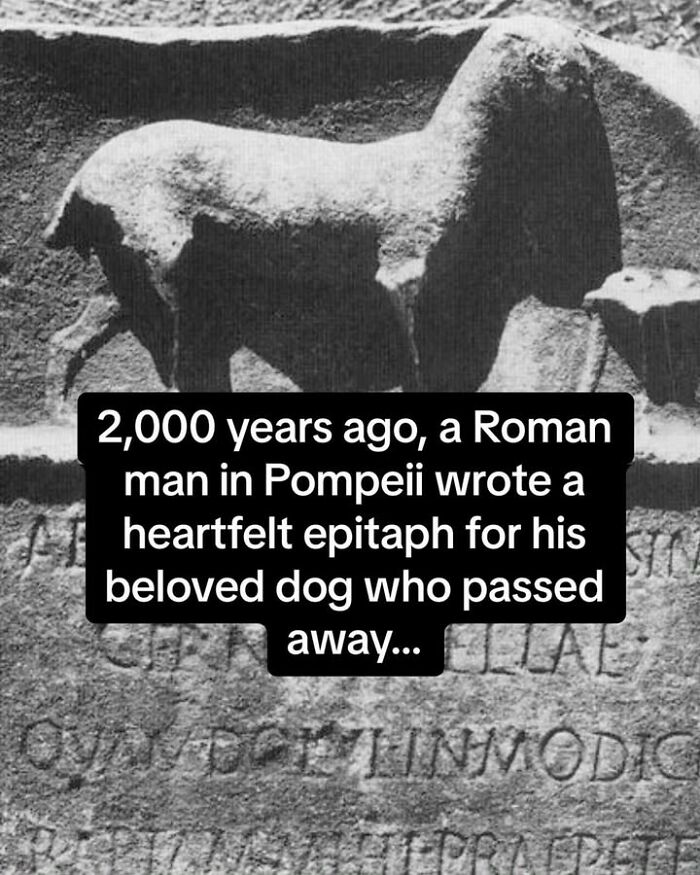
Image source: petshistorical
#5
According to Cat Magazine, this is the greatest cat painting ever made.
It’s called My Wife’s Lovers and was painted in 1891 by the Austrian artist Carl Kahler. It shows 42 Turkish Angora and Persian cats who were owned by the millionaire Kate Birdsall Johnson. That may sound like a lot, but Mrs. Johnson reportedly had some 350 cats in her Californian summer house.
My Wife’s Lovers was painted in 1891 by the Austrian artist Carl Kahler (1856-1906).
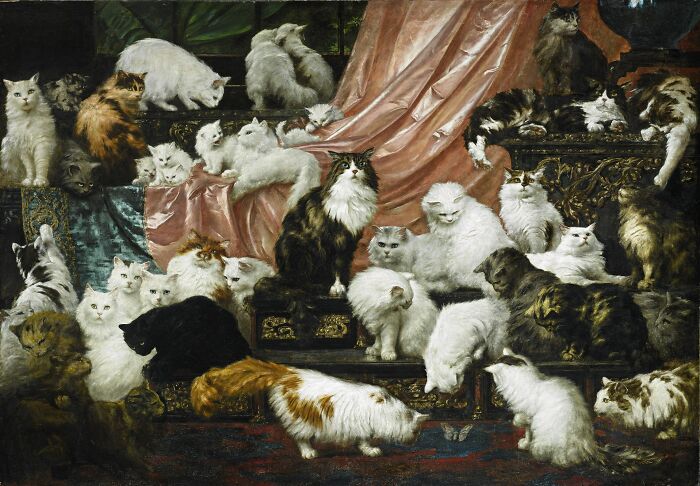
Image source: petshistorical
#6
The crowd gathered in a Minneapolis event hall in early July had spent the day watching players tackle video game challenges. But they cheered the loudest when a gamer called Peanut Butter took the stage to play the Nintendo sports game “Ken Griffey Jr. Presents Major League Baseball.”
Peanut Butter’s objective was to win a single baseball game. He sped through the game calmly, occasionally wagging his ears. As he neared victory, the crowd roared its support in a synchronized chant: “Who’s — a — good — boy?”
Then, when Peanut Butter pressed his paw down on a custom controller at just the right moment and hit a virtual home run for the walk-off win, the spectators erupted in glee.
Peanut Butter, a 4-year-old Shiba Inu, had cemented himself in gaming lore by completing the challenge in front of hundreds of fans. He celebrated by leaping forward and trying to lick a spoon of peanut butter.

Image source: petshistorical
#7
If there is ever a doubt about who is in charge, ask the Godfather 🐾Marlon Brando once said, “I live in my cat’s house.” The actor adored #cats throughout his life. The iconic #cat held by Brando in the 1972 classic “The Godfather” was actually a stray found on set.
As Don Corleone calmly explains his idea of “friendship” to the undertaker Bonasera, the first nearly full-body shot of the don reveals a fabulous, unexpected guest: a gorgeous gray and white cat sitting in Marlon Brando’s lap.
“The cat in Marlon’s hands was not planned for,” director Francis Ford Coppola said later. “I saw the cat running around the #studio, and put him in his hands without a word.”
Brando was mad for children and #animals, and it became part of the scene. But the sheer joy of the kitty nearly ruined the shot. The story goes that “when the #sound crew listened to Brando’s dialogue, they couldn’t understand a word he was saying and feared they would have to use subtitles.” The issue wasn’t the great Brando but, yes, the sublime cat, whose mellifluous #purring wrecked the sound. Listen to the “Godfather” track and you can still hear it. Happy cat! Here’s to Brando and all the cats who forever rule our homes. ❤️🐖
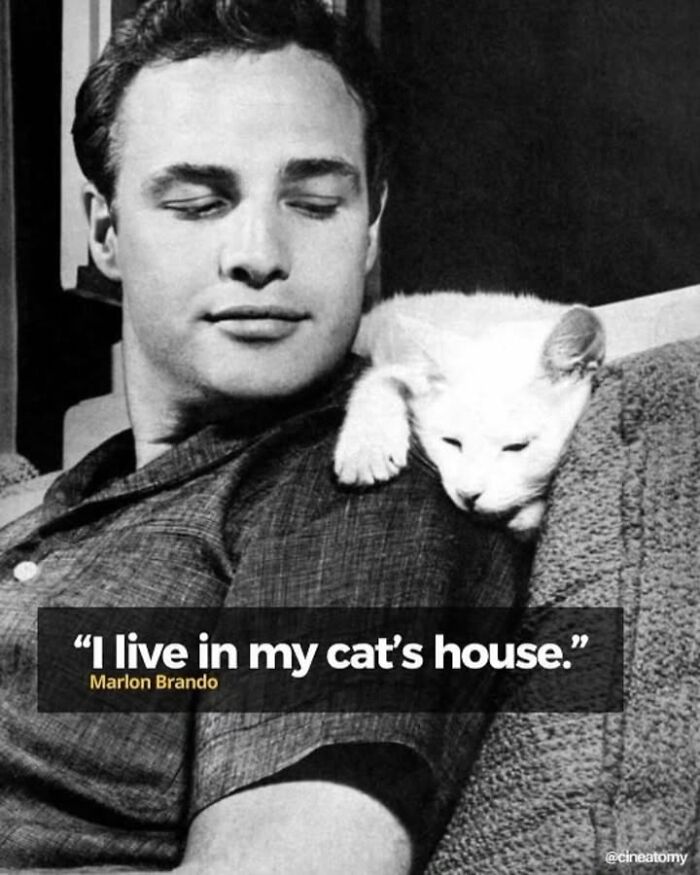
Image source: petshistorical
#8
On the morning of Tuesday, September 11, Michael Hingson, a sales director who had been blind since birth, arrived at his office on the 78th floor of Tower One at the World Trade Center. His guide dog, Roselle, took her usual spot under his desk. At 8:45 a.m., a hijacked plane struck the tower just 18 floors above them.
After calling his wife and ensuring his team had evacuated, Hingson began the long descent down 78 flights of stairs with Roselle. Navigating through smoke, debris, and crowds of people, they reached the lobby. As they got outside, Tower Two had already been hit and was collapsing. “It sounded like a metal and concrete waterfall,” Hingson recalled. They took cover in a subway entrance and later resurfaced as Tower One came down. Roselle then guided Hingson nearly 40 blocks to a friend’s apartment, bringing him to safety.
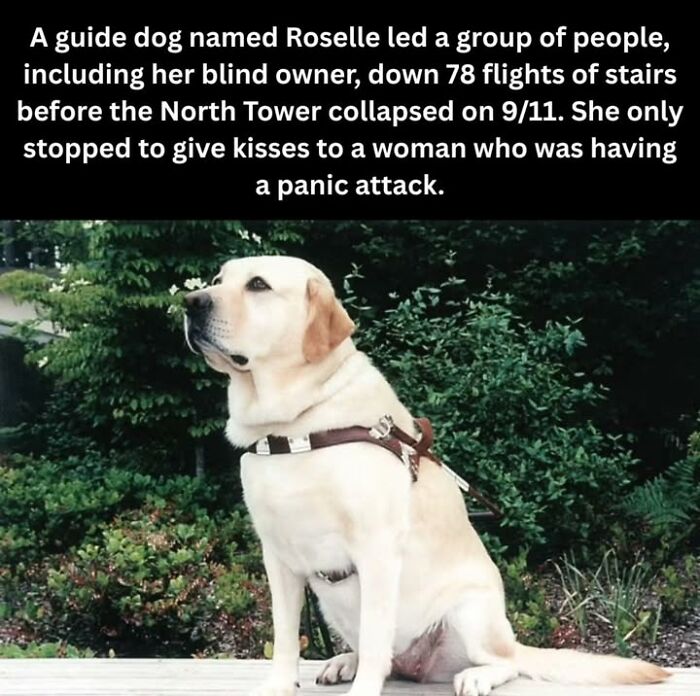
Image source: petshistorical
#9
US Marine Sergeant Frank Praytor, a combat correspondent with the 1st Marine Division during the Korean War (1951-1952), became widely known for a heartwarming photograph capturing him feeding an orphaned kitten named “Miss Hap” with a medicine dropper.
The kitten, whose mother was kill£d in a mortar barrage near Bunker Hill, was nursed back to health by Praytor using canned milk and meat from C-rations, showcasing a moment of compassion amid the brutality of war. The image, published in over 1,700 newspapers, brought him fame and even marriage proposals from women across the US.
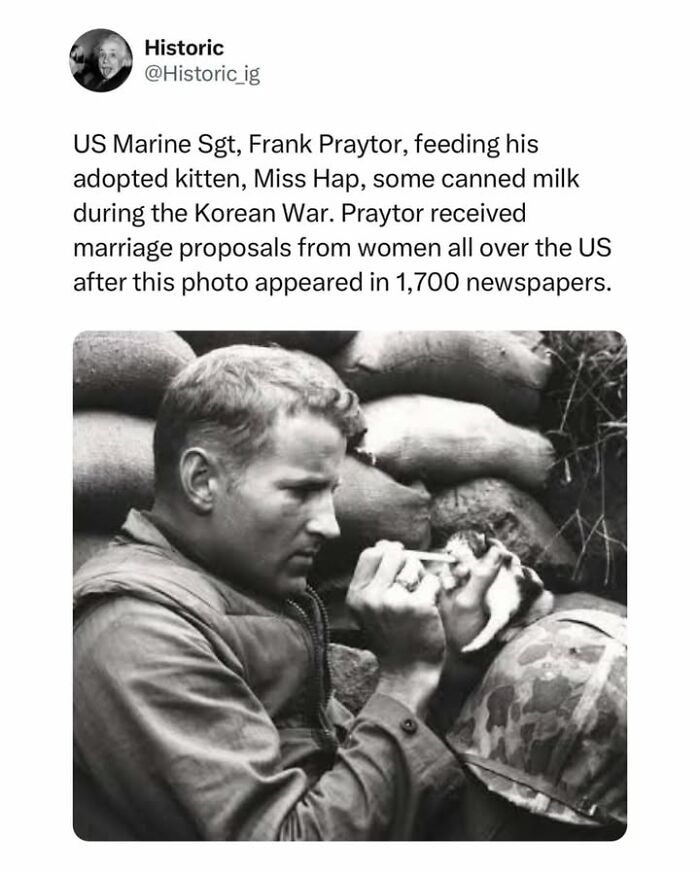
Image source: petshistorical
#10
In the 1930s, a black retriever named Swansea Jack became a legend in Wales after rescuing 27 people from drowning in the River Tawe and Swansea docks.
Jack fearlessly dove into the water to save lives, earning him medals, a silver cup, and the title “Dog of the Century.”
He became such a symbol of bravery that to this day, people from Swansea are proudly nicknamed “Jacks” in his honor.
His statue still stands along the Swansea promenade, a tribute to the city’s most heroic pup.
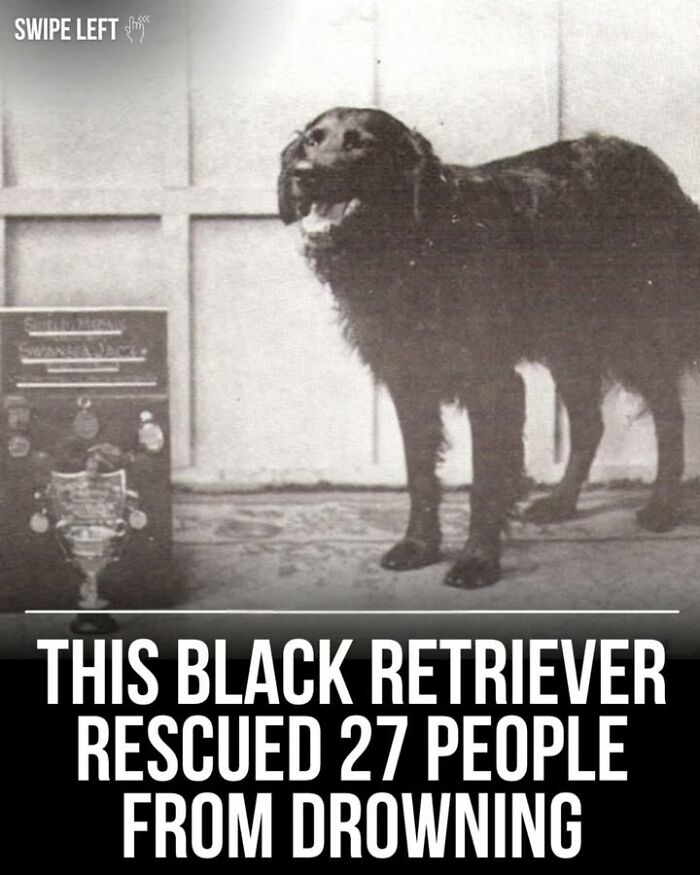
Image source: petshistorical
#11
“The more cats you have, the longer you will live. If you have a hundred cats, you will live ten times longer than if you have ten. One day, this will be known and people will have thousands of cats.” -Charles Bukowski
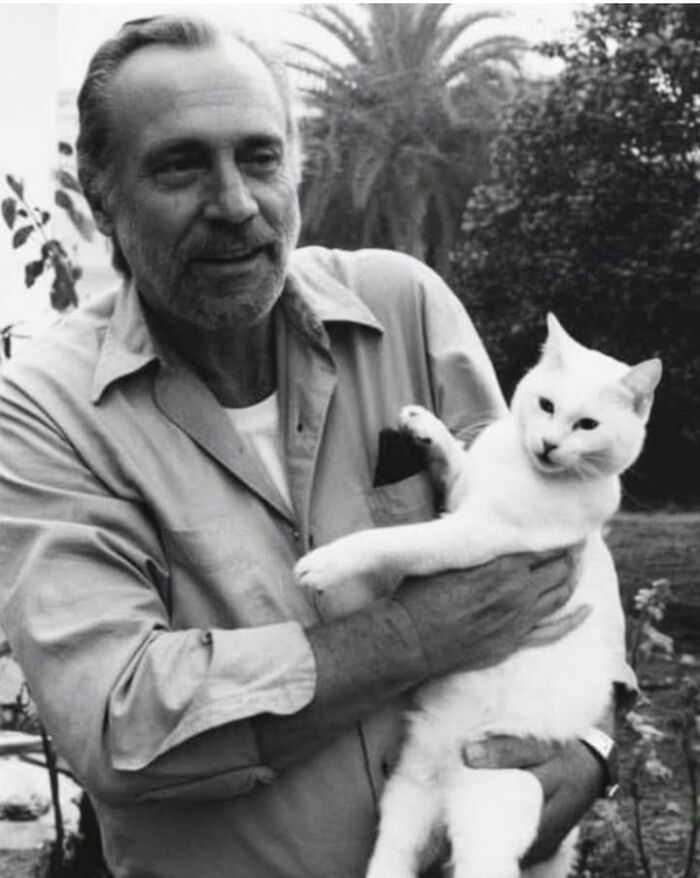
Image source: petshistorical
#12
This is Ruby, the last horse to leave the coal mines, stepping into the daylight on December 3, 1972, with flowers around her neck and music playing to honor her quiet courage. Like so many before her, Ruby spent her life in darkness, pulling heavy coal wagons underground, never feeling the sun or fresh air. Yet these horses carried on with quiet strength, knowing when their day should end and refusing to move if the burden was too much.
They worked side by side with their human partners, sharing the weight and silence of a world beneath the earth. Today, we take the time to honor Ruby and all the brave horses who lived and worked in the shadows, reminding us of their dignity and sacrifice. They will always be the ghosts of the coal mines.
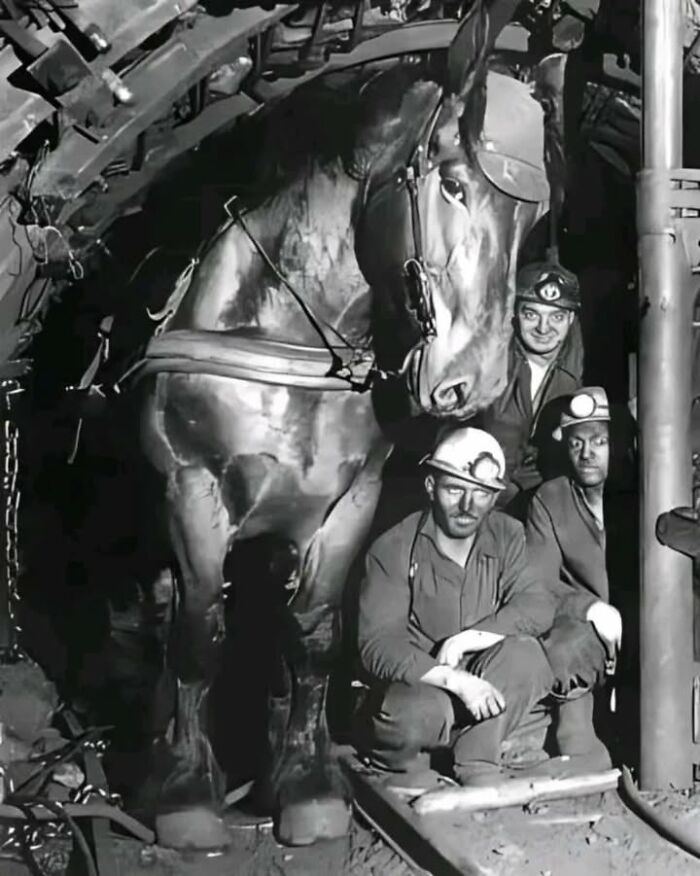
Image source: petshistorical
#13
“Specifically instructed to “rat” on anyone seen feeding Ranger.”
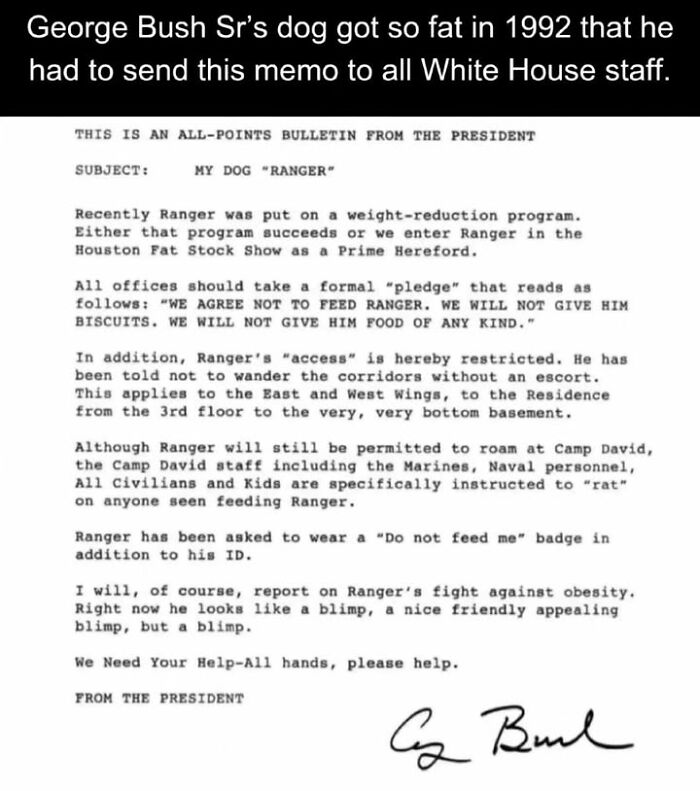
Image source: petshistorical
#14
She didn’t carry a weapon. She carried hope.
Judy was an English Pointer, born in Shanghai and raised aboard Royal Navy ships. She learned to navigate decks, sense storms, and bark at trouble long before war ever broke out. But nothing could have prepared her for what came next.
In 1942, her ship — HMS Grasshopper — was attacked and sunk by Japanese forces. Judy survived. She swam to shore alongside the crew, found freshwater in the jungle, and led them through enemy territory to safety.
But that was only the beginning.
Judy and the surviving crew were captured and sent to a Japanese POW camp. Life inside was brutal — hunger, disease, punishment. Yet Judy stayed with them. She became more than a mascot. She became a lifeline.
She barked warnings when guards approached. She shared scraps of food with prisoners. She chased off snakes and lifted spirits in a place where joy was nearly extinct.
Fearing she’d be killed, the prisoners hid her identity until one of them, Leading Aircraftman Frank Williams, managed to get her officially registered as a fellow prisoner of war — the only dog to ever hold that status.
She survived the camp. She returned home. And she lived out her days peacefully in England, finally safe beside the man who had shared her sentence.
I remember Judy not because she knew what war was — but because she knew who her people were. And she stayed with them. Through hunger, fear, and barbed wire.
We haven’t forgotten you, Judy. And we never should.
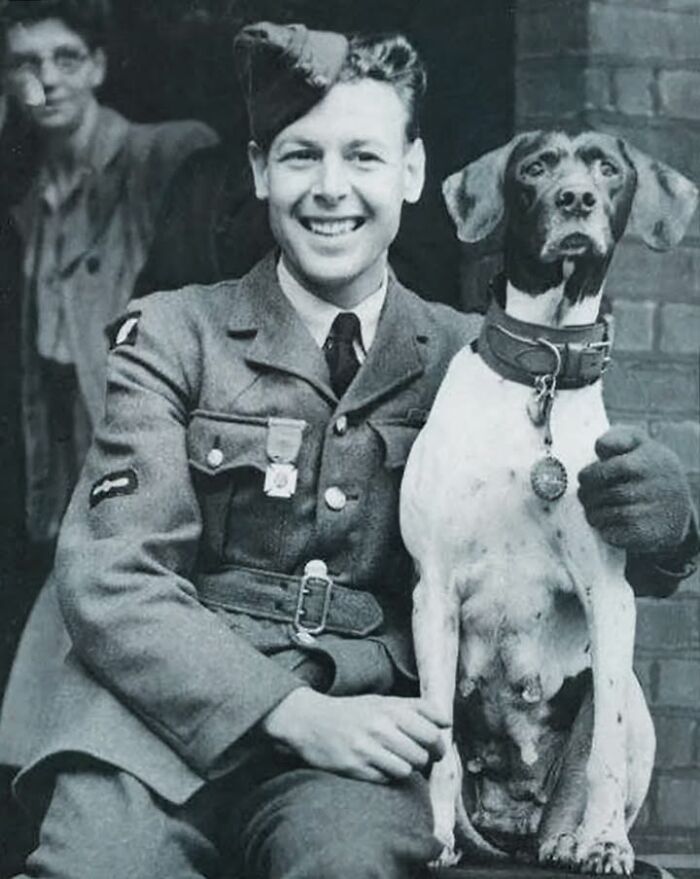
Image source: petshistorical
#15
South Africa’s last zoo elephant has been released back into the wild after 40 years of captivity.
At two years old, Charlie was captured from Zimbabwe’s Hwange national park to perform tricks at a circus.
He was later transferred to South Africa’s national zoo, but animal welfare groups voiced concern for his health.
During Charlie’s time there, he is said to have witnessed the death of four other elephants, including the death of his own calf.
The South African National Biodiversity Institute, which runs the zoo, denied the elephant was showing signs of distress.
“We have been working tirelessly to end the loneliness of Charlie,” said Four Paws CEO Josef Pfabigan.
The elephant’s new home is a 10,000-hectare reserve with a thriving population of his kind.
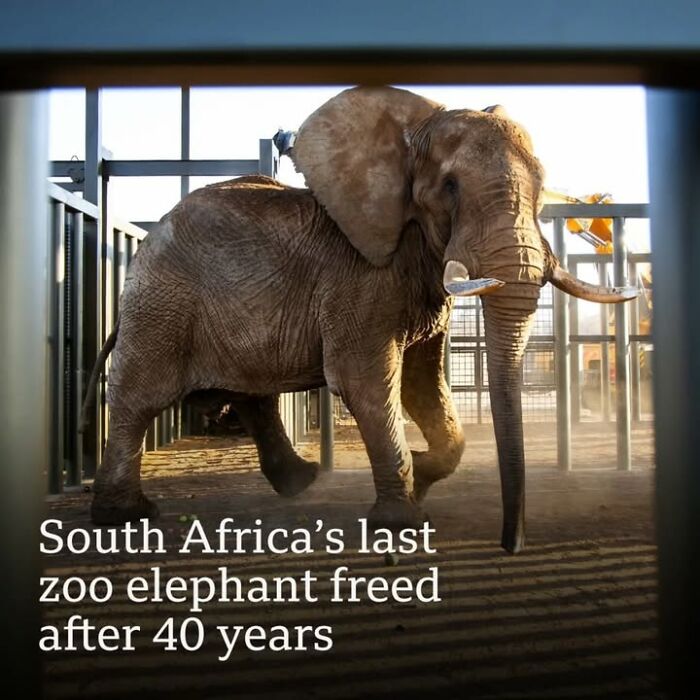
Image source: petshistorical
#16
In the small town of Plovdiv, Bulgaria, a curious error during the local election led to the oldest cat in the community, Sir Whiskers, being officially declared the new mayor. The mix-up began when a group of local teenagers jokingly added Sir Whiskers’ name to the online ballot as a write-in candidate. The prank caught on, and the town’s residents, amused and perhaps a bit enchanted by the idea, overwhelmingly voted for the feline candidate.
The morning after the election, officials were stunned to discover that Sir Whiskers had won the race by a landslide, outpacing several human candidates. The town council quickly convened to address the legality of a cat holding office. To everyone’s surprise, they found no specific rule in the town’s charter against a non-human mayor.
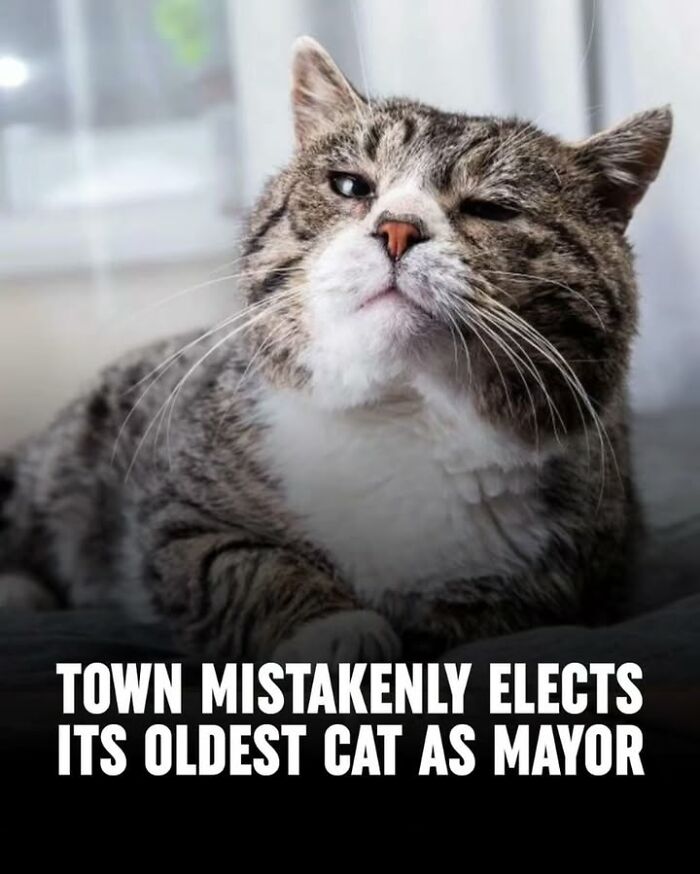
Image source: petshistorical
#17
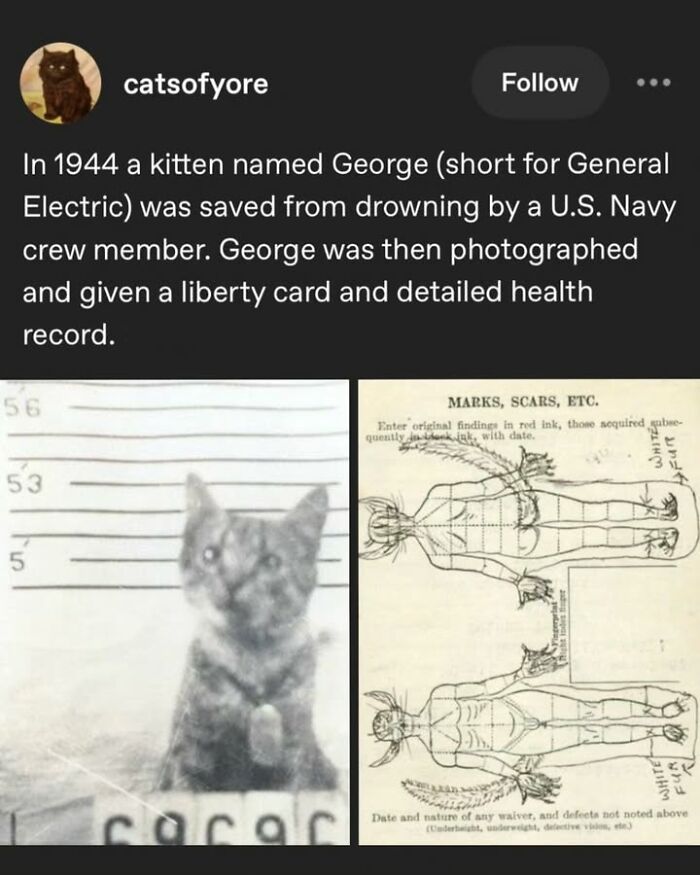
Image source: petshistorical
#18
Two boys sprint across Sarajevo’s notorious Sniper Alley in 1995, clutching their dog as they flee danger.
During the Bosnian War, this stretch, including Ulica Zmaja od Bosne and Meša Selimović Boulevard, was lined with Serbian sniper positions, turning it into a deadly gauntlet for civilians.
To cross safely, people either dashed through at full speed or waited for UN armored vehicles to use as moving shields. By 1995, snipers had injured 1,030 people and killed 225—60 of them children.
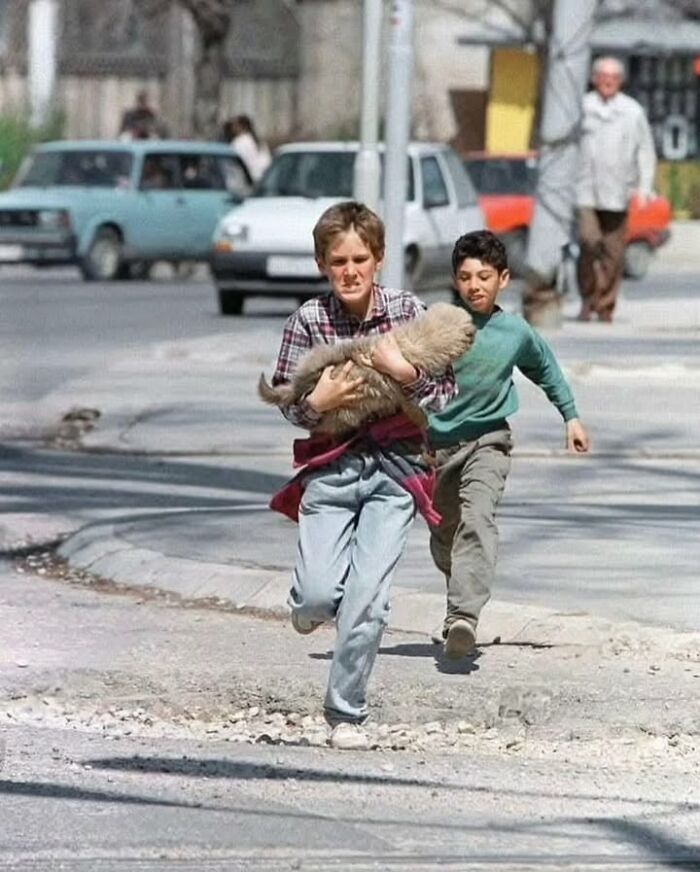
Image source: petshistorical
#19
George, the brave Jack Russell Terrier saved five children from a vicious attack by two pit bulls in Manaia, New Zealand. Despite being much smaller than the attacking dogs, George courageously defended the children, barking and rushing at the pit bulls to protect them. He was so severely mauled in the fight that a veterinarian had to put him down due to the extent of his injuries. George’s bravery didn’t go unnoticed. The New Zealand Society for the Protection of Animals awarded him a bravery medal, and he was also awarded the PDSA Gold Medal by the People’s Dispensary for Sick Animals. This medal is considered the animal equivalent of the George Cross, a testament to George’s extraordinary act of bravery. They also erected this monument.
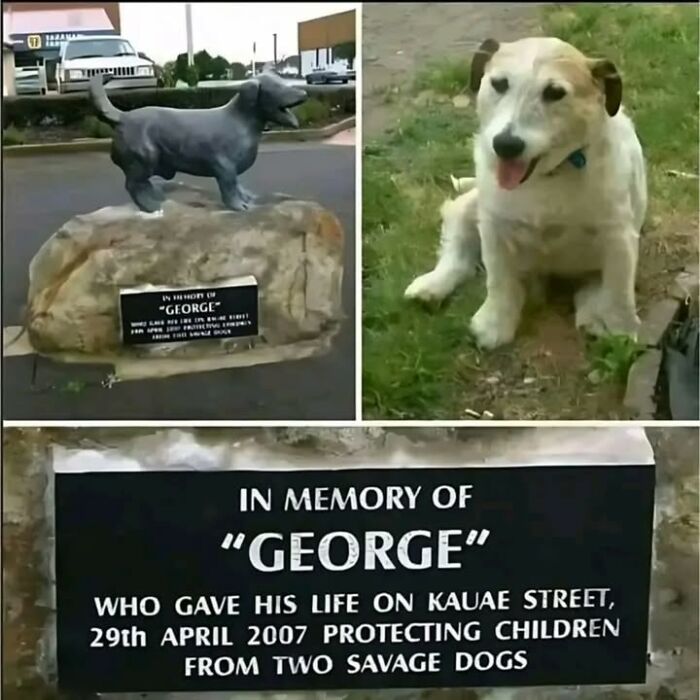
Image source: petshistorical
#20
In May 2020 Chartwell welcomed Jock VII, a six-month-old rescue kitten, to take up this unique role.
Along with his white bib and white paws, Jock VII has a very mischievous character. His favourite pastimes are investigating what the gardeners are up to and playing down in the long grasses of the orchard. He also likes lots of cuddles on the sofa after an eventful day.
Keep an eye out for him as you tour the property.
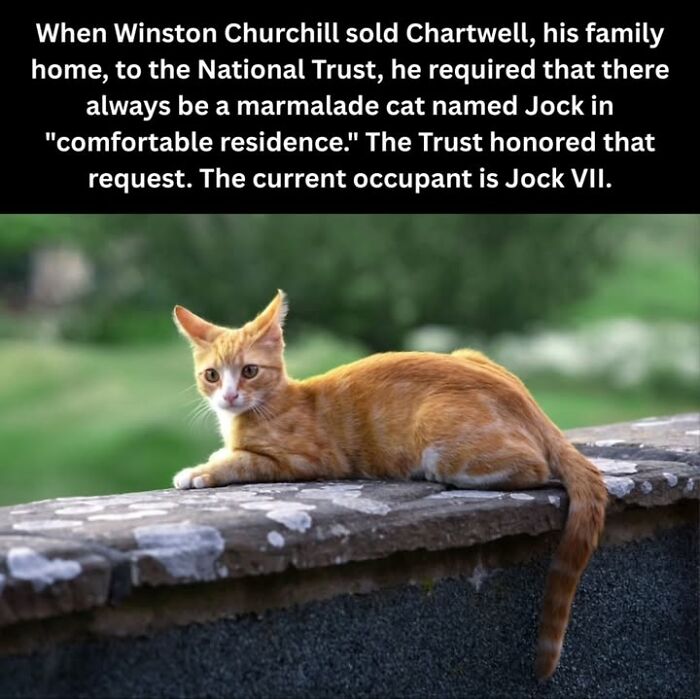
Image source: petshistorical
#21
Camberley Kate, And Her Stray Dogs In England. She Never Turned A Stray Dog Away, Taking Care Of More Than 600 Dogs In Her Lifetime (1962)
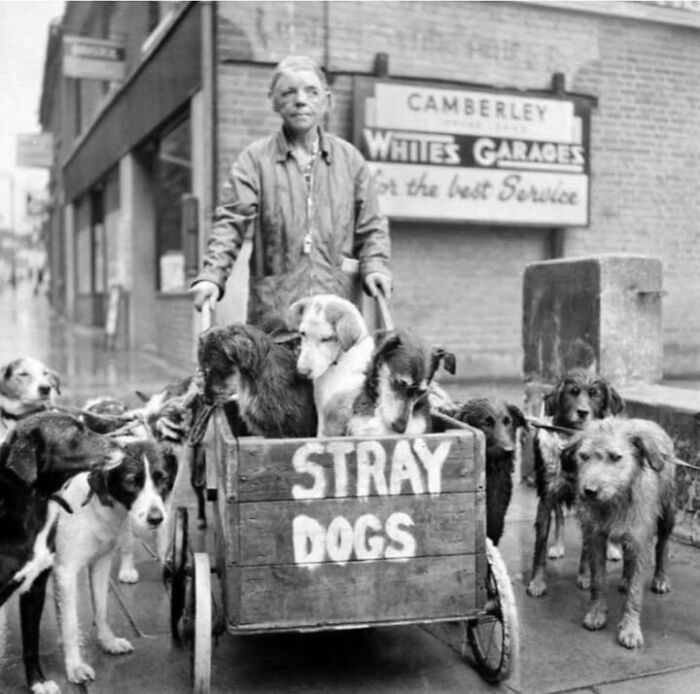
Image source: petshistorical
#22
Willie: The War Hero’s Shadow 🇺🇸
Meet Willie, the loyal Bull Terrier who never left General George S. Patton’s side during WWII. Originally named Punch, he was once the beloved pet of an RAF pilot who sadly never returned from a mission. Willie eventually found a new home with Patton in 1944 — not named after William the Conqueror as many think, but after a boy Patton met during the Great Depression.
Through the campaigns in France, Belgium, and Luxembourg, Willie marched with the General, earning his place in history — and in countless war photos. After Patton’s tragic death in 1945, Willie was captured mourning his best friend, a heart-wrenching image of loyalty and loss. He lived out his days with the Patton family, passing away in 1955.
Today, a 12-foot bronze statue honors them both at the General Patton Memorial Museum 🗿🐶
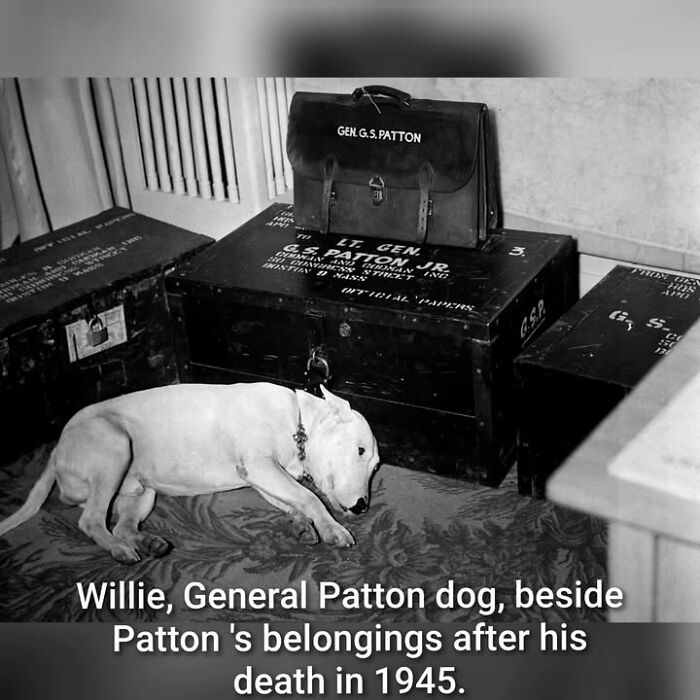
Image source: petshistorical
#23
During World War Ii, a Great Dane named Juliana became a canine hero. In 1941, a German incendiary bomb landed in her owner’s home in England. Without hesitation, Juliana urinated on the device, extinguishing it before it could cause an explosion. Her quick thinking saved lives and earned her a medal for bravery from the Blue Cross, an animal welfare charity.
Juliana’s story doesn’t end there-she received a second Blue Cross Medal in 1944 for alerting her owners to a fire in their shop. While her first act of heroism is often recounted with humor, it underscores the incredible instincts and intelligence of animals, even in the face of war.
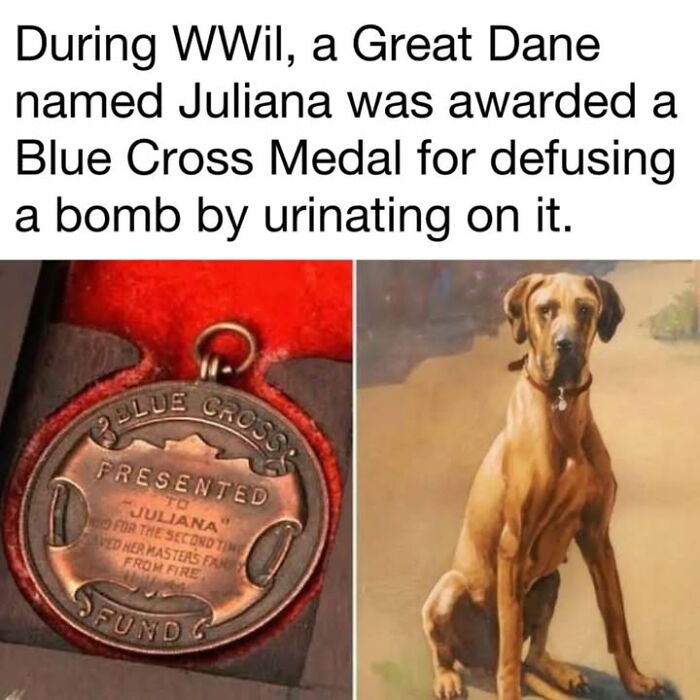
Image source: petshistorical
#24
Creme Puff, born on August 3, 1967, in Austin, Texas, holds the record as the oldest cat ever documented, living until August 6, 2005—38 years and 3 days. Owned by Jake Perry, a plumber, she earned a spot in the Guinness World Records for her remarkable longevity, far exceeding the typical cat lifespan of 12–18 years.
Perry credited her long life to an unconventional diet of bacon, eggs, asparagus, broccoli, and coffee with heavy cream, along with a unique living setup that included a converted room with outdoor access and a mini movie theater showing nature documentaries. Whether it was the diet, environment, or genetics, Creme Puff’s record remains unmatched, making her a legendary figure among felines.
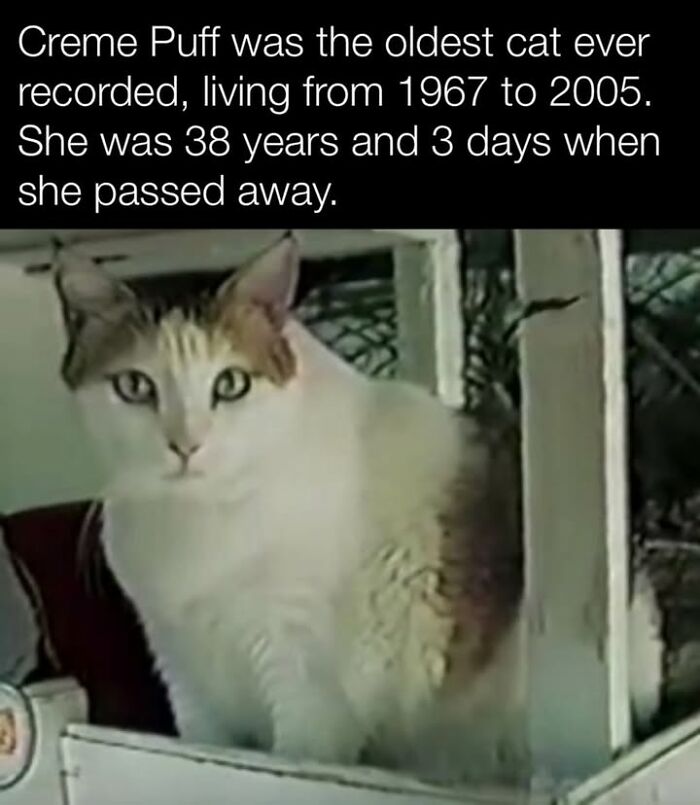
Image source: petshistorical
#25
You’ve probably heard of Balto, the sled dog famous for completing the last leg of the 1925 serum run to Nome, Alaska.
However, there’s another dog from that run who’s only recently been recognized for his heroism.
Togo, who was very ill as a puppy and initially considered unfit for sledding, was given away as a pet. Defying expectations, Togo jumped through a closed window to rejoin his sled-dog siblings, impressing the renowned musher Leonhard Seppala.
Despite being a troublemaker and only 48 pounds, Togo eventually won Seppala over. Before a significant trip, Seppala confined Togo with orders not to release him until the team had departed. Togo escaped and caught up with the team overnight, surprising Seppala the next day. Seppala then harnessed Togo, who immediately excelled, covering 75 miles on his first official day—a remarkable feat for an inexperienced sled dog.
In 1925, a diphtheria outbreak threatened over 10,000 people in the area, particularly children. The only viable medicine was in Anchorage, 1,000 miles away, and with aircraft engines frozen and the nearest rail line 674 miles away, sled dogs were the only solution.
Seppala’s team, led by the 12-year-old Togo, undertook the most perilous leg—a shortcut across Norton Sound—during a blizzard and through the dark. In just 5 ½ days, the serum reached Nome.
Togo and Seppala covered an astounding 264 miles, while other teams averaged only 31. In 2011, Time named Togo the most heroic animal ever, and in 2022, a statue of Togo was unveiled in Maine, where he spent his final years. Disney released a film about Togo in 2019, featuring Willem Dafoe as Seppala and Togo portrayed by Diesel, a direct descendant of Togo.
Seppala aptly summed up the story: “I thought of the ice and the darkness and the terrible wind and the irony that men could build planes and ships. But when Nome needed life in little packages of serum, it took the dogs to bring it through.” We honor Togo with our Hughes.
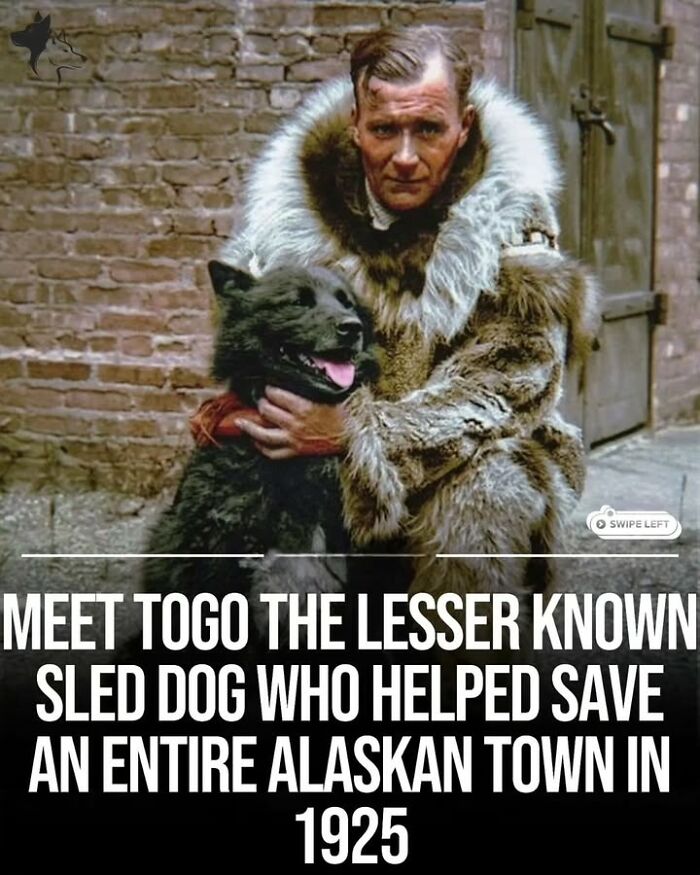
Image source: petshistorical
#26
In 2014, a remarkable survival story unfolded deep in the Siberian wilderness. Four-year-old Karina Chikitova wandered away from her remote village in Russia’s Sakha Republic, following her father into the forest.
Unnoticed and lost, she spent 11 days alone in the wild, accompanied only by her loyal puppy, Naida. Facing freezing nights, Karina stayed warm by cuddling with Naida and survived by foraging for wild berries and drinking river water.
After nine days, Naida returned to the village—sparking hope and leading rescuers to Karina, who was eventually found alive, weak but safe. Her resilience, courage, and the loyalty of her dog turned her ordeal into an extraordinary story of survival!
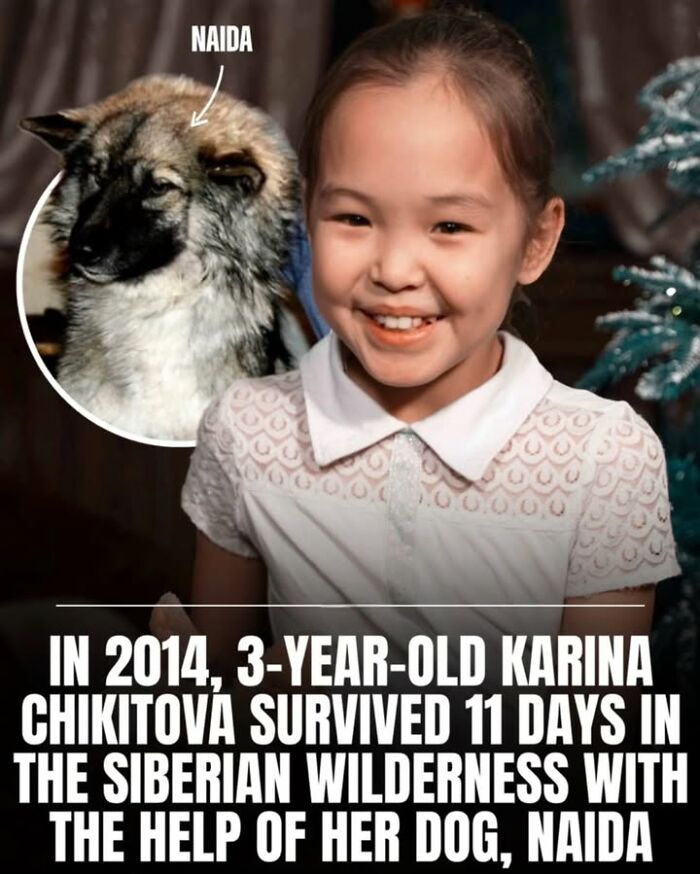
Image source: petshistorical
#27
Pepper the Cat and Louise Fazenda taking a rest during the filming of “Are Waitresses Safe?” Circa 1917.
Pepper was a female Oriental Maltese cat who had starring turns in several silent comedy films produced by the Mack Sennett Studios from 1917 to 1922. Noted for her exceptionally photogenic good looks and her catty yet lovable personality, Pepper became the first true celebrity feline in film history.
Louise Fazenda (June 17, 1895 – April 17, 1962] was an American film actress, appearing chiefly in silent comedy films.
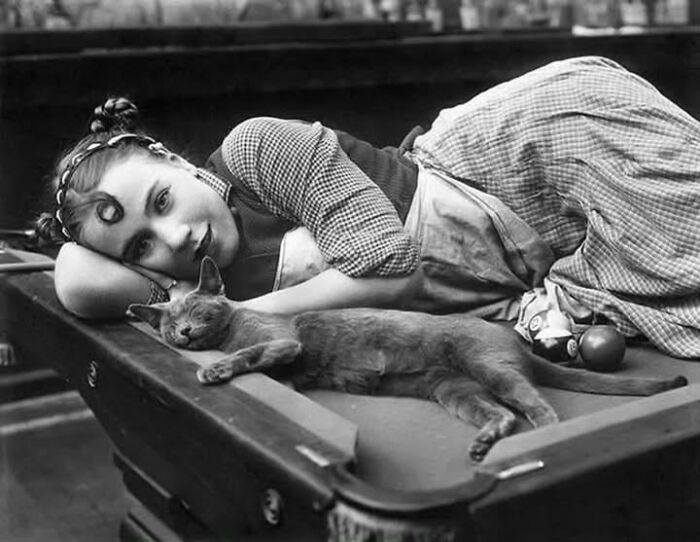
Image source: petshistorical
#28
In 1960 Operation Cat Drop was launched as an unusual but effective response to a devastating rat infestation in the remote village of Bario in Borneo. After insecticide spraying to control malaria-carrying mosquitoes accidentally killed off the local cat population the rat numbers exploded. These rats were destroying food supplies and threatening the village’s survival. To combat this, the British Royal Air Force parachuted crates containing live cats into the area along with other supplies. The cats were released to naturally reduce the rat population and restore balance to the local ecosystem.
The use of cats was not the only innovative part of the operation. Along with cats, the parachuted crates sometimes contained other animals like dogs and beavers to help with pest control and maintain security. This creative wildlife management technique relied on nature itself to address a problem caused by human intervention. The cats quickly adapted to their new environment and became an effective line of defense against the invasive rats. Villagers welcomed the animals and worked alongside them to protect their homes and food stores.
Operation Cat Drop stands as a remarkable example of ecological problem-solving through unconventional means. Rather than relying solely on chemicals or traps the intervention used living creatures to restore order. This method highlighted the importance of biodiversity and the role animals play in supporting human communities. The operation remains a fascinating story of how teamwork between humans and animals saved a village and prevented further disaster.
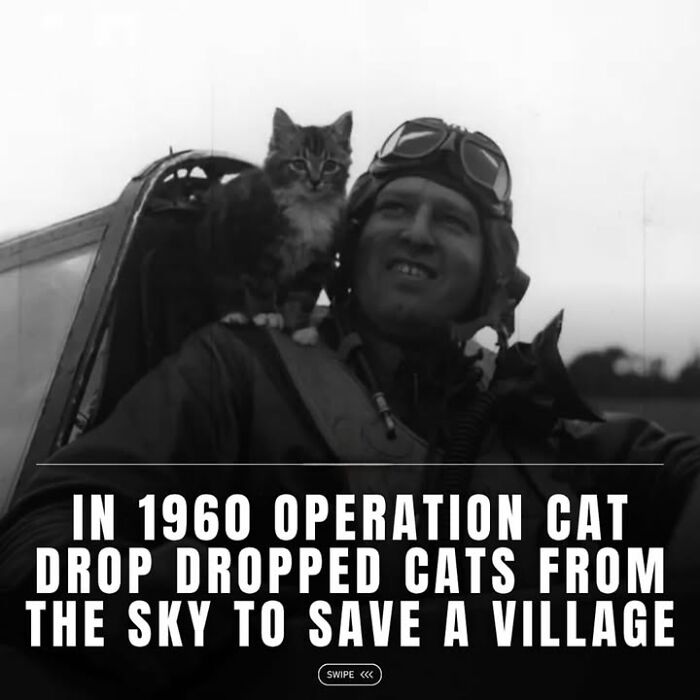
Image source: petshistorical
#29
Human Population: 13
Cat Population: 210
Aoshima also known as “Cat Island” in Ozu, Japan, is renowned for its overwhelming cat population, originally introduced to control rodents on fishing boats. As the human population declined, the cats thrived, attracting many tourists.
All cats on Aoshima Island are being neutered or sterilized, according to major media reports. The reason is that there are too few people on the island who can feed them.
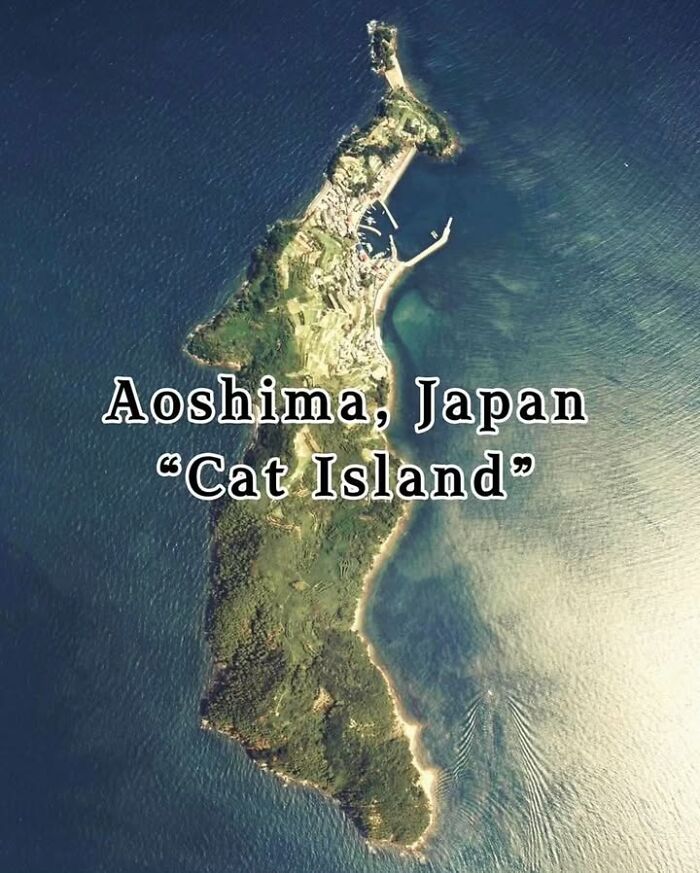
Image source: petshistorical
#30
Almost 100 years ago, a police officer stopped traffic in New York to ensure the safe crossing of a mother cat carrying her kitten (1925).
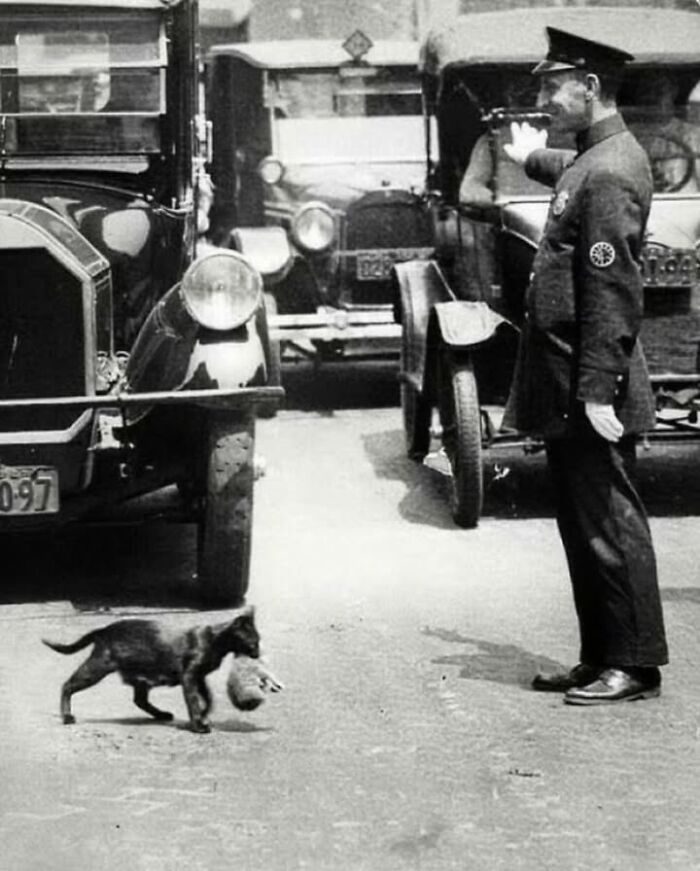
Image source: petshistorical
#31
The Boss Bear – also known as Bear 122 – is the most famous grizzly bear in Banff National Park.
Depending on the time of year, the Boss of Banff can be anywhere from 500 – 650lbs. He’s huge! Because of his massive size, he has the first pick of all the best food. He has even been seen snacking on smaller bears!
Being the most dominant male of the Park, the Boss is thought to have fathered up to 70% of the grizzlies in Banff.
Steve Michel, a human wildlife conflict specialist with Banff National Park, said researchers believe “The Boss” grizzly was struck by a train several years ago, lived, and continues roaming Banff.
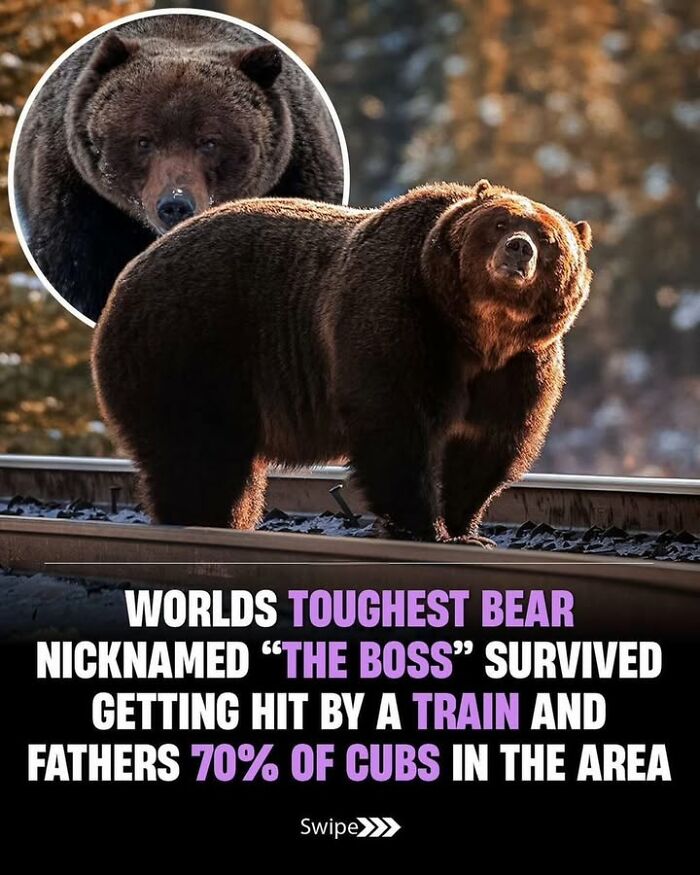
Image source: petshistorical
#32
Hachiko, an Akita dog born around 1921-1923 in Japan, became a symbol of unwavering loyalty. In 1924, Hidesaburō Ueno, a professor at the Tokyo Imperial University, brought him to live in Shibuya, Tokyo.
After Ueno’s passing in 1925, Hachiko faithfully waited for his return at Shibuya Station daily for over nine years, capturing the hearts of the Japanese people with his remarkable display of devotion.
In 1934, a bronze statue was unveiled at Shibuya Station in Hachiko’s honor. Hachiko passed away in 1935, but his legacy of loyalty continues to inspire people worldwide.
The last photo shows Hachiko with his owner’s partner, Yaeko Ueno (front row, second from right), and station staff in mourning in Tokyo on March 8, 1935.
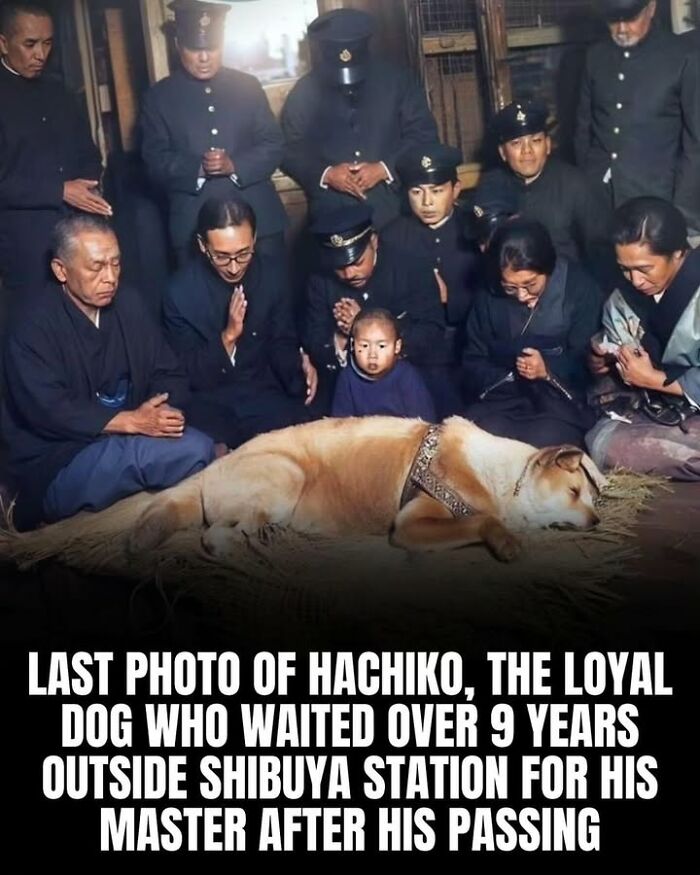
Image source: petshistorical
#33
Dogs across Nepal have been celebrated for a day with flower garlands, bright paint and food.
The celebrations were part of the five-day Nepalese Hindu festival, Tihar.
Kukur Tihar, known as “day of the dogs”, is the second day of the festival on which dogs are celebrated and appreciated for their loyalty and companionship to humans.
Hindus believe that the dog is the messenger of Yamaraj – the God of death.
The festival, which shares some traditions with Diwali in India, also celebrates cows and crows.
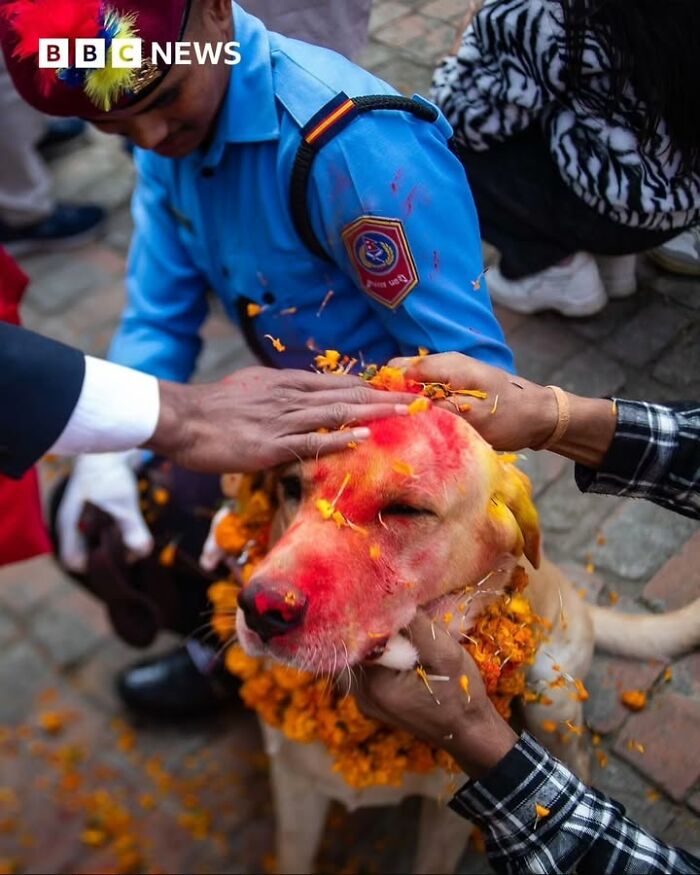
Image source: petshistorical
#34
Black cat auditions in Hollywood in 1961. 152 cats lined up to audition for a role in The Tale of Terrors (1962). It turned out the role had already been given to a ‘professional’ cat, so none of these cats were given the role.
Photographed by Ralph Crane for LIFE magazine, it was written, “as far as anyone could remember, it was the biggest invitation to bad luck ever seen in one place.”
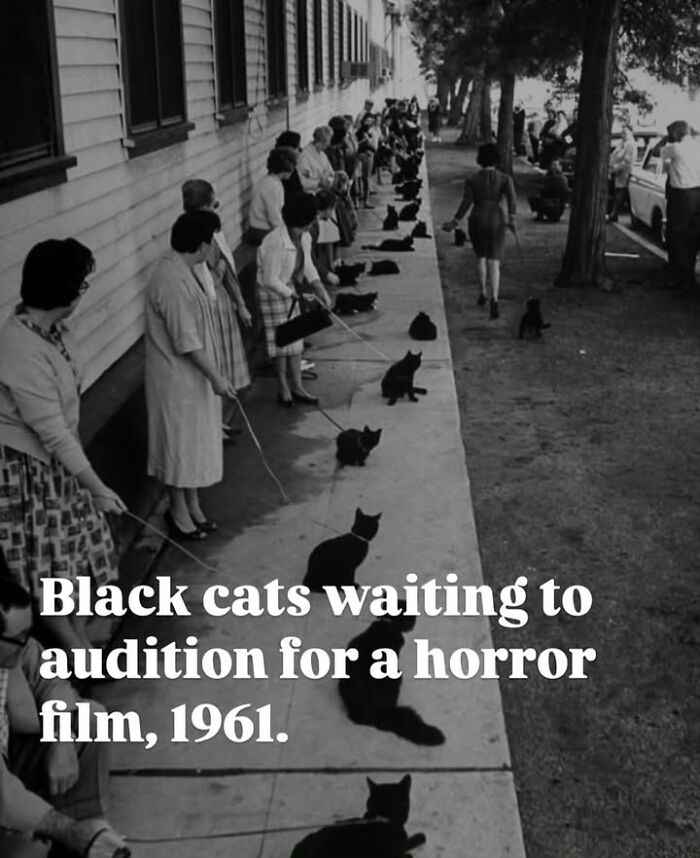
Image source: petshistorical
#35
The late monarch has been immortalized with her beloved corgis in the English town of Oakham. The bronze statue was unveiled April 21 — on what would’ve been Queen Elizabeth’s 98th birthday.
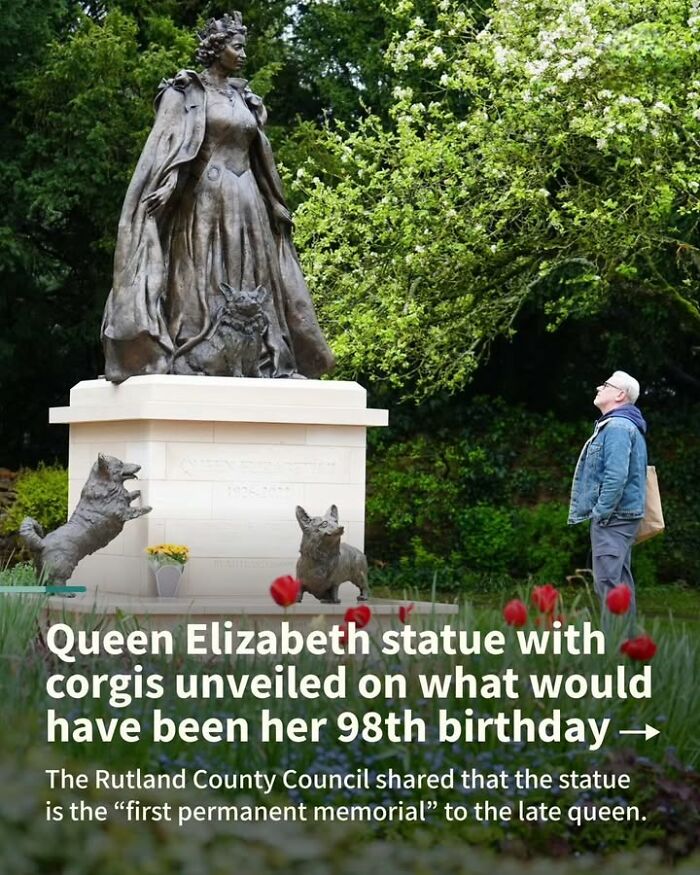
Image source: petshistorical
#36
In 1952, Macy’s formed a canine security corps at their flagship Herald Square department store. Six Doberman Pinschers were introduced. They were provided by John Behan, a dog trainer who had been in the Army’s K-9 Corps during World War II.
Once customers left for the day, the dogs took over. They worked as night security guards, patrolling Macy’s two million square feet of retail space from the sub-sub-basement to the twentieth floor. They prowled the aisles at night, inspecting shipping bays, looking under counters, and sniffing every corner of the store. Each dog was taken out on a leash, but at certain points, they were released and told to “search.” They were on the look out for burglars and thieves, stragglers caught after hours, and indications of fire or water leakage.
One time, two young girls were reported missing and traced back to Macy’s enormous store. They were found by a Doberman guard dog who, to the surprise of his handler, licked the girls’ hands to put them at ease.
The dogs were looked after by a staff of nine. They slept in the penthouse, and hung out in four fenced-in dog runs, each with its own large, heated and air conditioned doghouse. They were bathed weekly in the summer, and bi-monthly in the winter. The dogs ate a special diet and saw a veterinarian twice a year, along with regular pedicures and dentals. They even put on demonstrations at the Madison Square Garden horse show.
Most of the Dobermans were 7, and tended to work until they were 10 or 11 years old. After that, they were sold or given away for less-demanding work.
Anthony Nicola, Macy’s VP of Security, explained “This building has 2 million square feet. We have alarms and sensors, but they fill in the gap. Their sense of smell is terrific. You can’t buy an alarm that does what they do.”
There’s record of Doberman security guards at Macy’s as late as 1998, but I could find no proof that the program still exists today. Rumor has it it does not. Do you know?
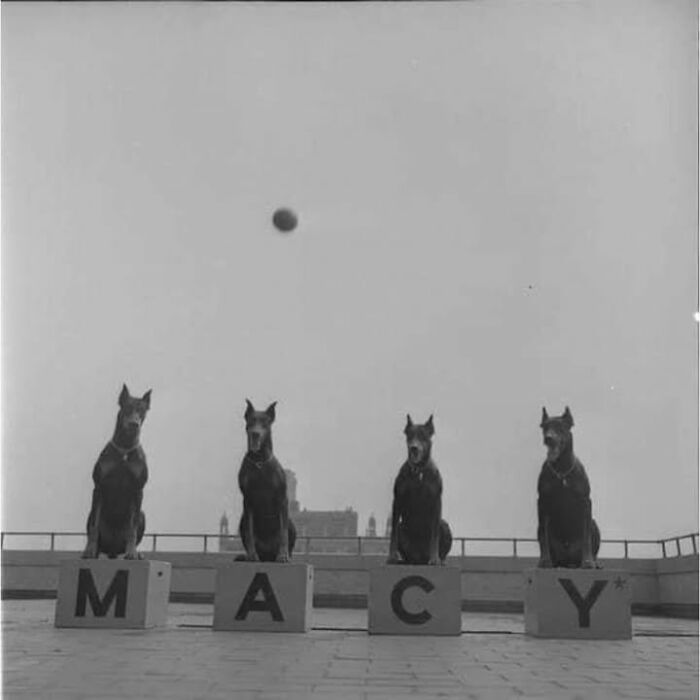
Image source: petshistorical
#37
In 2004, when the Indian Ocean tsunami struck, a young hippo named Owen was swept away from his herd, left adrift and alone on the shores of Kenya. Lost between the waves of sorrow, fate led him to Haller Park, a wildlife sanctuary, where an unexpected companion awaited him—Mzee, a 130-year-old Aldabra tortoise.
In his solitude, Owen saw in Mzee the shadow of the mother he had lost. He began to follow the old tortoise everywhere, seeking warmth in her ancient shell and comfort in her slow, steady steps. Though they were worlds apart—by species, by time, by nature itself—a bond beyond logic grew between them. A friendship that defied boundaries, proving that love and kindness recognize no form, no age—only the meeting of two souls in need.
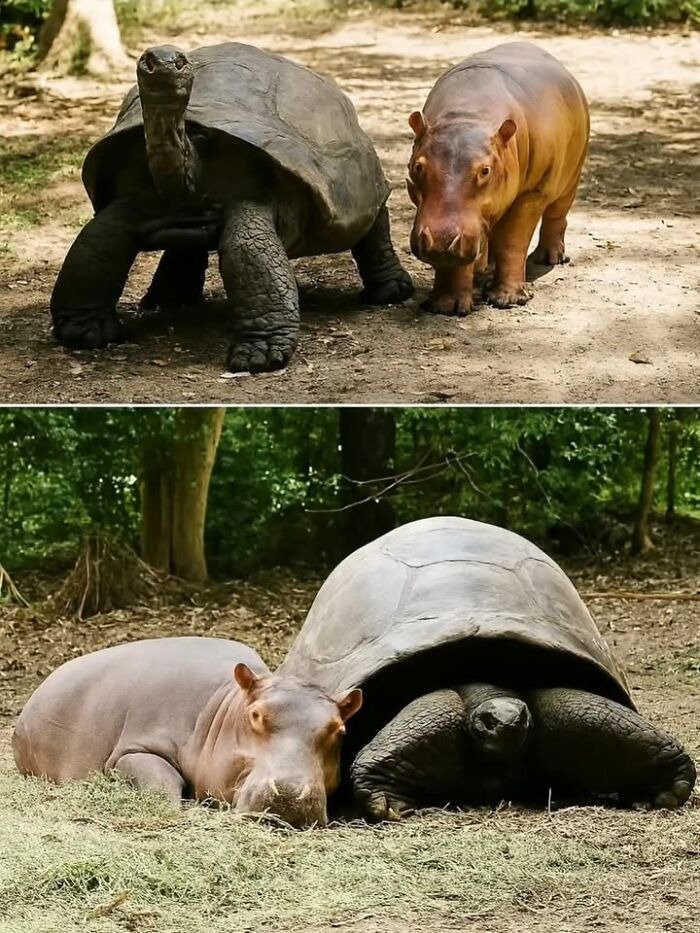
Image source: petshistorical
#38
He charged a machine gun nest. They tried to take his medals away.
Chips wasn’t bred for war. He was a family dog — part German Shepherd, part Collie, part Husky — donated by his owners in New York when the U.S. Army asked for help. The program was called “Dogs for Defense.” And Chips answered the call.
In 1943, during the Allied invasion of Sicily, Chips and his handler were pinned down by gunfire. The enemy had a machine gun position dug into the beach, and no one could advance.
Chips broke free.
He ran straight into the fire — disappeared into the pillbox — and forced the entire enemy crew to surrender. When he came back out, his face was burned from the gun’s muzzle flash and he had a bullet graze across his head.
Later that same day, he helped capture ten more enemy soldiers.
The Army awarded him a Silver Star, a Purple Heart, and a campaign ribbon with an arrowhead. His story was in the papers. He was a hero.
But it didn’t last.
The War Department soon ordered his medals revoked. “Animals,” they said, “cannot receive military honors.” It wasn’t about what Chips had done — it was about the rules. The image. The precedent.
So they took the medals away. But not the memory.
Chips went home after the war and returned to the family that had once let him go. He lived out his life in peace — without ribbons, but never forgotten by those who had seen what he did.
And in 2018, long after he was gone, he was posthumously awarded the Dickin Medal, the highest military honor for animals.
I remember Chips not just because of how he fought — but because of how quickly we tried to forget. His story reminds us that real courage doesn’t need permission. It just acts.
We haven’t forgotten you, Chips. And we never should.
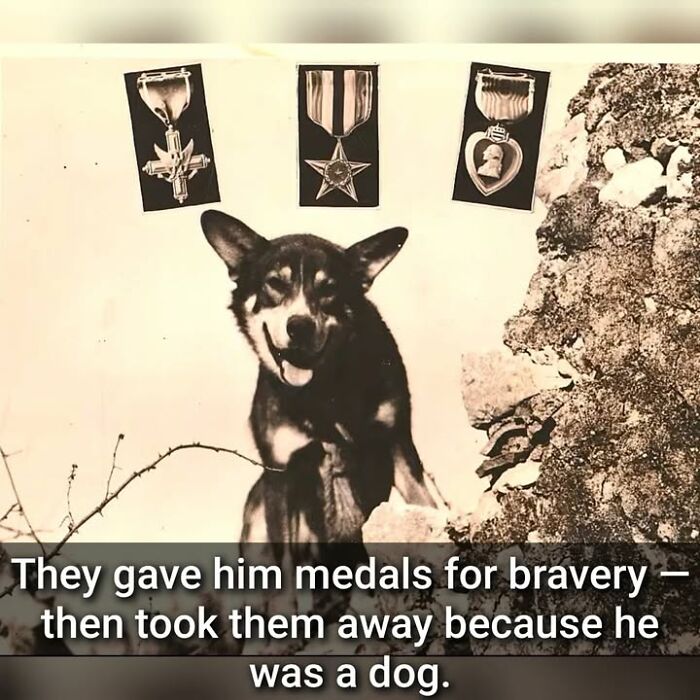
Image source: petshistorical
#39
Ernest Hemingway and his Cuban cat by Hans Malmberg, 1954.
Ernest Hemingway was known for many things, including his love for cats and writing. At his home in Key West, he kept a colony of cats, many of which were polydactyl, meaning they had extra toes. These cats, known as Hemingway’s six-toed cats, have become a beloved attraction at the Ernest Hemingway Home and Museum.
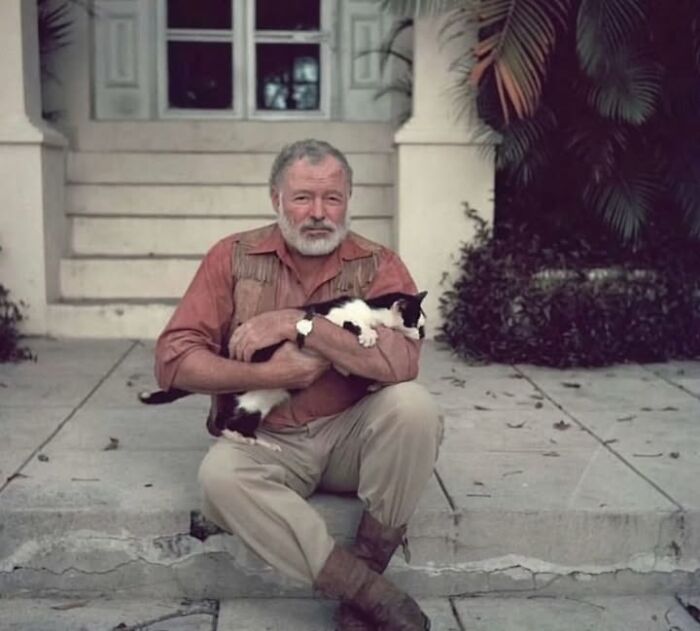
Image source: petshistorical
#40
The Dog People – On a tiny island off the coast of South Korea, one sweet dog made sure the visiting photographer had a friendly escort. The golden retriever followed the visitor everywhere as he photographed the street view map of the area. As a result, this dog is now in all the images!
The island of Jukdo boasts a beautiful landscape, as you’ll see if you follow this handsome golden retriever tour guide along trails around the coastline. Here is the link for a virtual tour. Jukdo has daily ferry service, which tourists use to enjoy the pristine ecosystem and visit the observatory.
If you’ve ever spent time looking at the street view level on Google maps, you’ve probably seen some interesting things. Some people use services like Mapcrunch to drop themselves into a random location to explore the scenery. And, apparently, find dog friends!
Jukdo has a small area of farmland used to grow medicinal herbs. The friendly golden retriever probably belongs to a family on the island. Thanks for the tour, friendly doggo.

Image source: petshistorical
#41
Duke Ellington Morris is the first feline to qualify for the airport’s Wag Brigade − a team of certified stress-relief animals. Before serving at his local airport, he lived a life on the city streets.
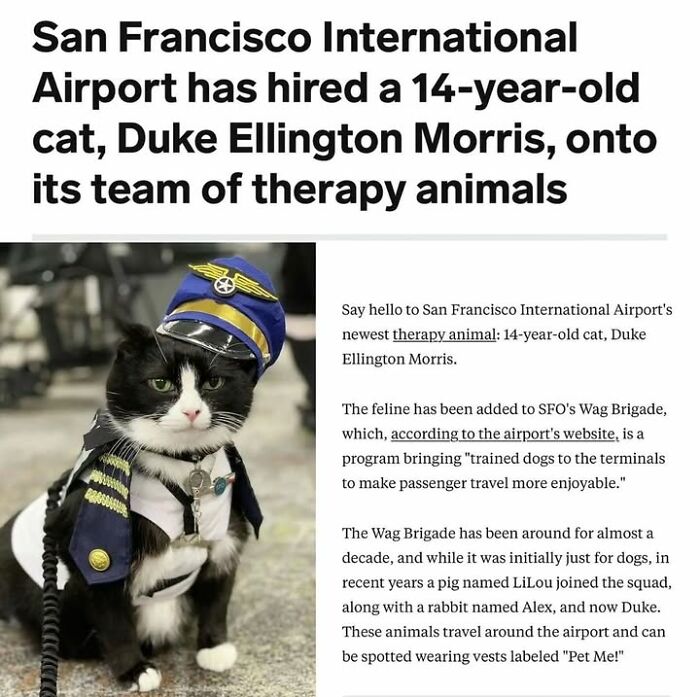
Image source: petshistorical
#42
In 1965, at just 16 years old, Robin Lee Graham embarked on a solo voyage to sail around the world. While he became known as “the boy who sailed alone,” he wasn’t entirely without companionship—his cat accompanied him throughout the journey.
Over several years, Graham navigated vast oceans, enduring storms, isolation, and numerous obstacles. Setting sail from California, he crossed multiple seas and, in the end, became the youngest person at the time to complete a solo circumnavigation.
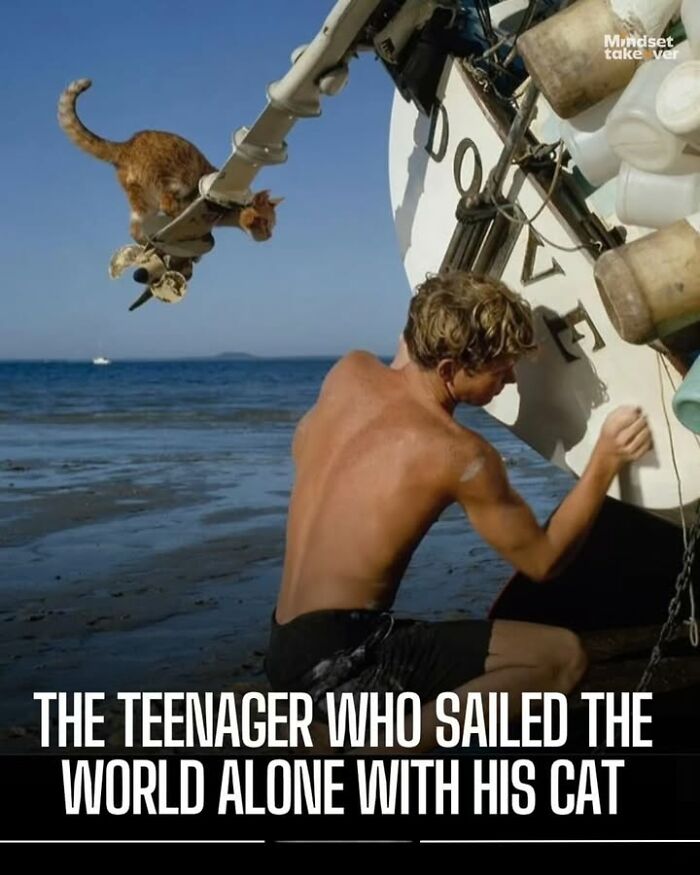
Image source: petshistorical
#43
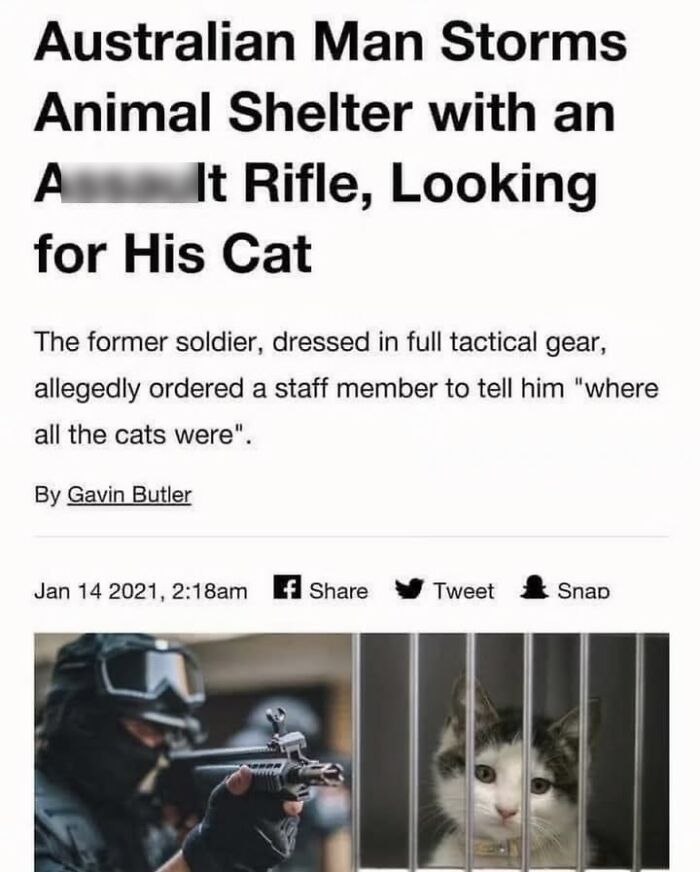
Image source: petshistorical
#44
He didn’t wear a helmet. But he stood between danger and his men.
Gander was a Newfoundland dog — massive, shaggy, and gentle by nature. He originally belonged to a family in Canada, but after a playful scratch on a child, he was rehomed with soldiers stationed nearby. They named him Gander, and he became their companion, their guardian, and eventually, their comrade.
When the Royal Rifles of Canada were deployed to Hong Kong during World War II, Gander went with them.
At first, he lifted spirits — a reminder of home in a foreign, hostile place. But when battle broke out during the Japanese invasion of Hong Kong in December 1941, Gander became more than a mascot.
The men even promoted him to Sergeant — not just as a sign of affection, but as a form of protection. With a rank, Gander couldn’t be removed as a “non-essential animal.” He was one of them.
And when it mattered most, he acted like it.
He charged enemy soldiers to protect the wounded. He barked warnings. He stayed at the front lines. And then, during one of the final assaults, someone threw a live grenade toward a group of injured Canadians.
Gander didn’t hesitate.
He grabbed the grenade in his mouth and ran. It detonated away from the men — killing him instantly, but saving their lives.
For decades, Gander’s sacrifice lived only in memory. But in 2000, he was posthumously awarded the Dickin Medal, sometimes called the “animal Victoria Cross.”
I remember Gander not just because of what he did — but because he didn’t know he was in a war. He only knew his people were in danger. And that was enough.
We haven’t forgotten you, Sergeant Gander. And we never should.
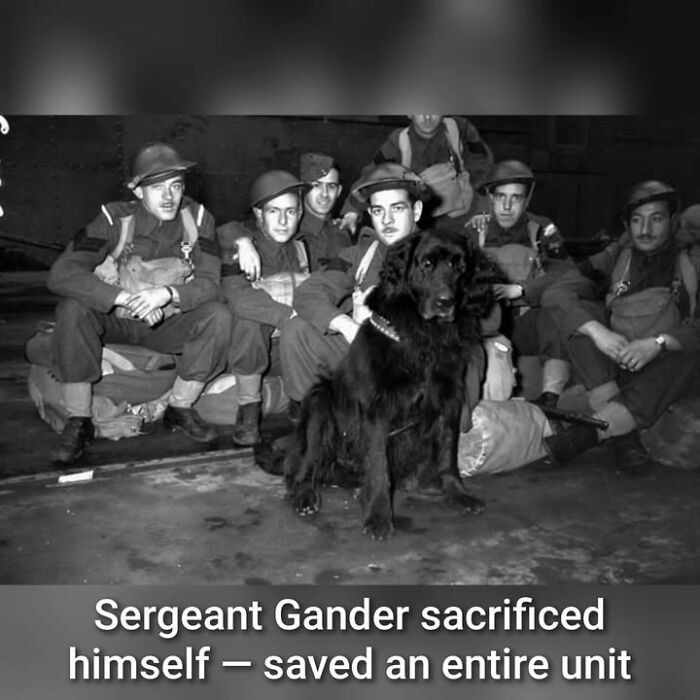
Image source: petshistorical
#45
The RMS Titanic carried more than just people on its ill-fated maiden voyage—it also transported twelve dogs, reflecting the luxury and status of its wealthier passengers. These canine companions included a variety of breeds such as a French Bulldog, a Pekingese, a Fox Terrier, two Pomeranians, and even a Great Dane. Cared for in the ship’s kennels or in the cabins of first-class passengers, these animals were as much a part of the voyage as their owners.
When disaster struck on the night of April 14, 1912, chaos reigned as passengers scrambled for safety. Amid the confusion, only three of the twelve dogs managed to survive: a Pekingese and two Pomeranians. Their small size likely enabled them to be hidden in coats or smuggled onto lifeboats, a luxury the larger dogs didn’t have. The fate of most of these animals mirrored the tragedy faced by the majority of the ship’s passengers.
One particularly poignant story is that of Elizabeth Isham, a devoted dog owner traveling with her Great Dane. When told her dog was too large to board a lifeboat, Elizabeth made a heartbreaking choice—she refused to leave him behind. Days later, rescuers found her body in the ocean, still clutching her beloved companion. Her act of loyalty and love stands as a deeply human moment amid the vast scale of the Titanic disaster.
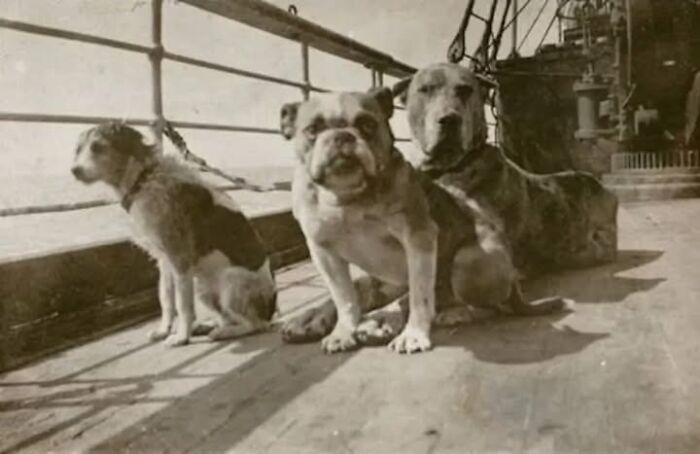
Image source: petshistorical
#46
Samuel Clemens, also known by his pen name as Mark Twain, absolutely adored cats.
He wrote that “When a man loves cats, I am his friend and comrade, without further introduction.” These photographs from the National Portrait Gallery’s collection were taken by his biographer, Albert Bigelow Paine. Make sure to show your feline friends a little extra love.
Thank you to the @themarktwainhouse for collecting these purrr-fect quotes. 🐱💬 📸: “Samuel Clemens” photographed by Albert Bigelow Paine. National Portrait Gallery, Smithsonian Institution.
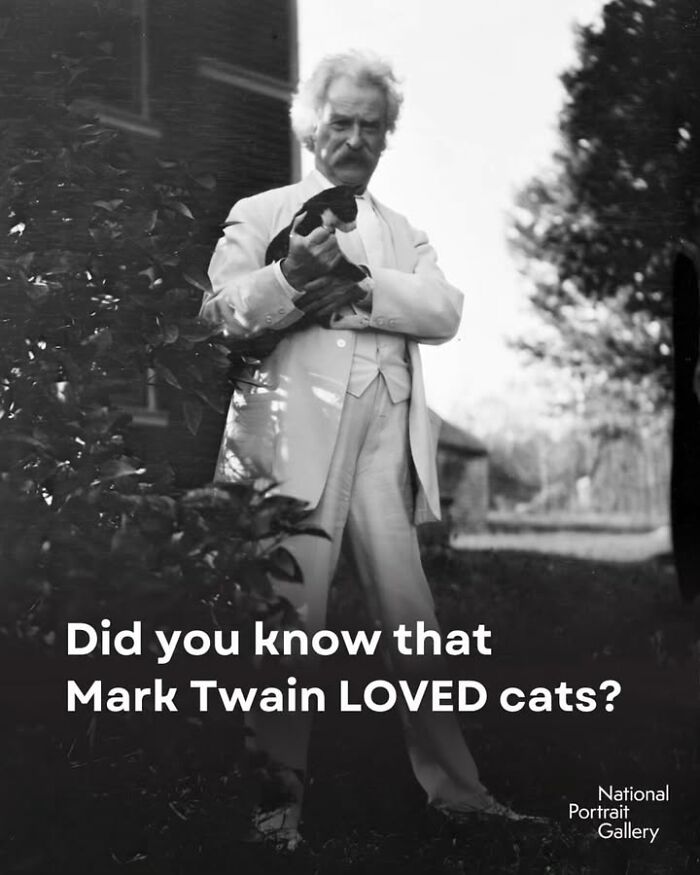
Image source: petshistorical
#47
You’ve heard of Trim and Red Lead… but have you met Tiddles?
Born at Camp X in 1943, Tiddles became the beloved mascot of HMAS Gympie — sailing into hearts and wartime naval history. Whether curled up in a sailor’s bunk or prowling the deck like she owned the ship (she did), Tiddles was a furry morale booster during WWII.
From ship to shore, his pawprint lives on. 🐾Scroll through for Tiddles story 📸
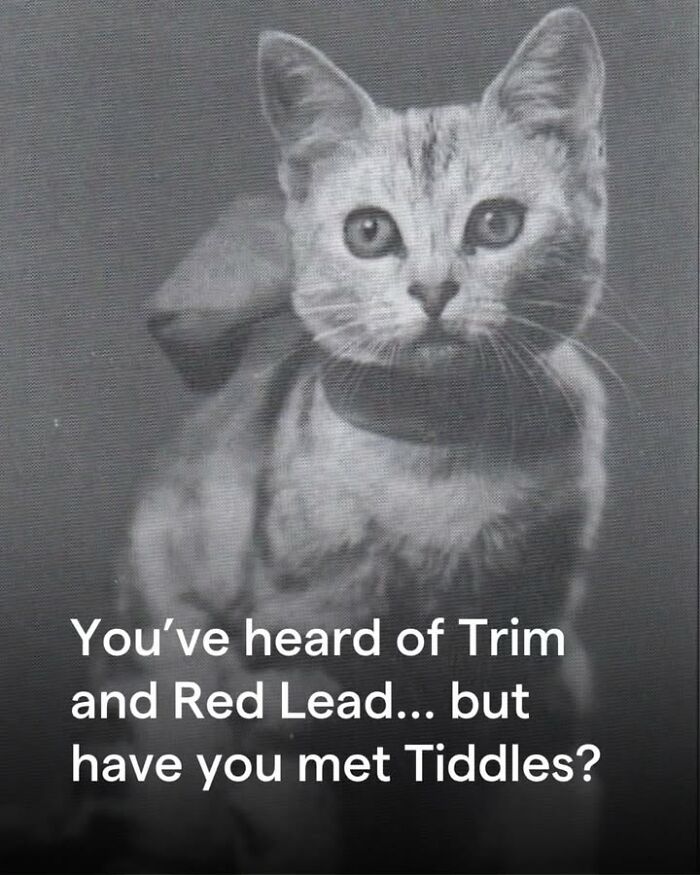
Image source: petshistorical
#48
In the harsh winter of 1925, the remote town of Nome, Alaska, faced a deadly diphtheria outbreak. With the port frozen and no planes able to fly in the brutal weather, the only way to get the life-saving antitoxin to the town was by dog sled. The serum was located in Anchorage, nearly 700 miles away. A relay of 20 mushers and over 150 sled dogs was quickly organized to transport the medicine across the unforgiving Alaskan wilderness—a journey that would come to be known as the “Great Race of Mercy.”
Gunnar Kaasen was tasked with completing the final and most treacherous leg of the journey, and leading his team was a Siberian Husky named Balto. Battling blizzard conditions, whiteout visibility, and temperatures plunging to -50°F (-45°C), Kaasen and Balto pushed forward through the night, relying on instinct and sheer determination. On February 2, 1925, just over five days after the relay began, they arrived in Nome with the antitoxin. The serum was distributed in time, and the outbreak was contained—largely due to the courage and endurance of the mushers and their dogs.
Balto became a national hero almost overnight, symbolizing resilience, teamwork, and the bond between humans and animals. Statues were erected in his honor, most famously in New York City’s Central Park, where children still read the inscription: *“Endurance · Fidelity · Intelligence.”* While Balto led the final stretch, the feat was a collective triumph of all the mushers and dogs involved in the serum run. Their legacy endures as a powerful reminder of bravery in the face of adversity and the vital role of working animals in human history.
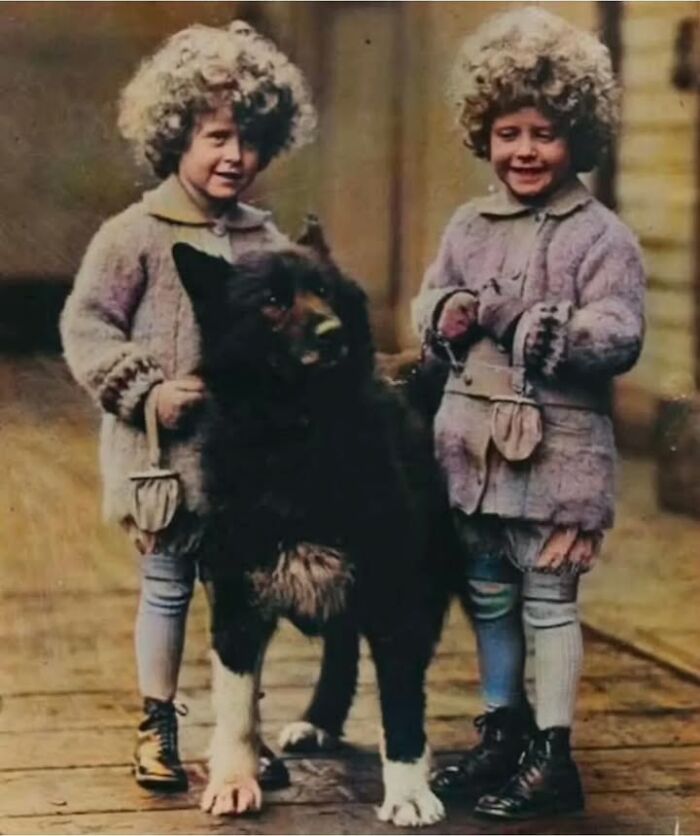
Image source: petshistorical
#49
Meet Rainbow – a once-obese cat who has now lost half her body weight after being re-homed
Rainbow was a teeny kitten, but quickly piled on the pounds
Now she’s slimmed down from a cat-astrophic 12.7kg to a pawfect 6kg
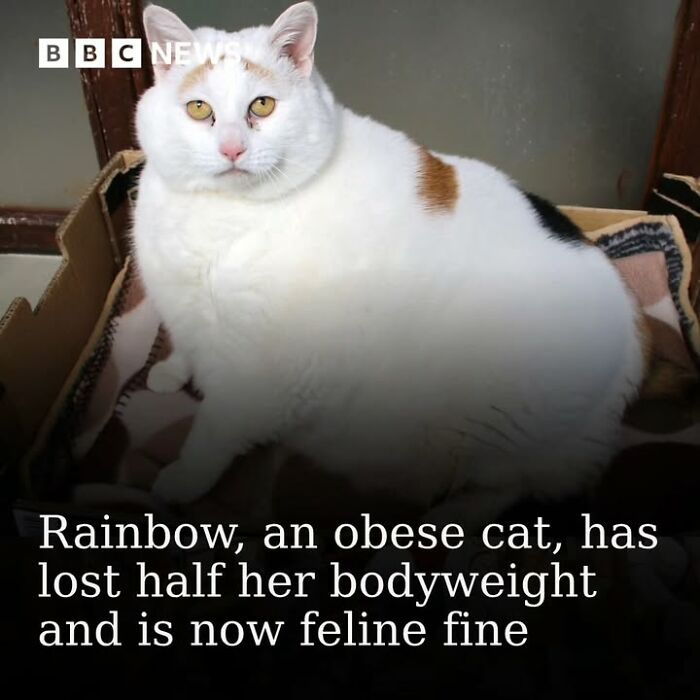
Image source: petshistorical
#50
A purr-fect way to spend the evening! Shanghai Museum has pulled in crowds this summer for an exhibition of ancient Egyptian relics including cat statues and other feline imagery.
On Saturday nights, it hosts up to 200 visitors and their 4-legged friends for Meow Night, inspired by ancient Egyptians’ worship of cat deity Bastet.
Visitors bring their cats in carriers or pet strollers and can take them out only at designated areas, such as for a photo opportunity next to a statue of Bastet.
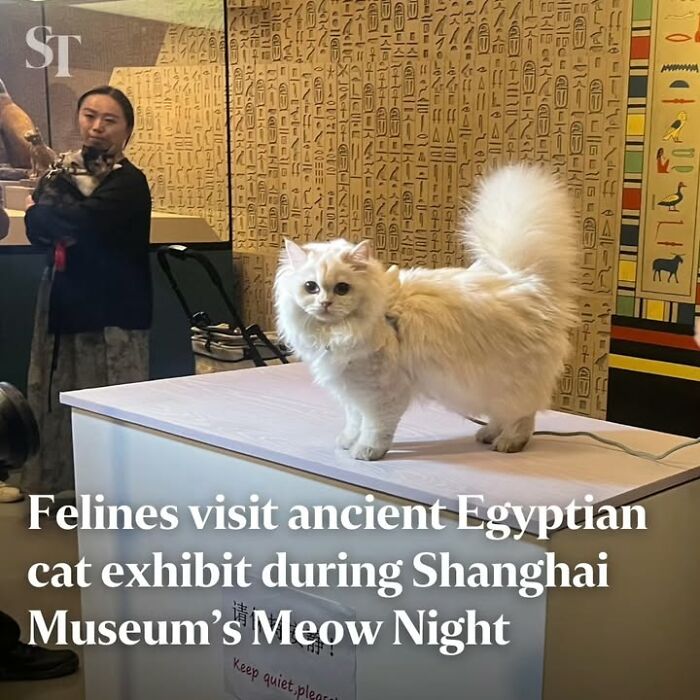
Image source: petshistorical
#51
A poem from Charles Bukowski’s “On Cats”, published posthumously 21 years after his passing in 1994.
My Cats
I know. I know.
they are limited, have different
needs and
concerns.
but I watch and learn from them.
I like the little they know,
which is so
much.
they complain but never
worry,
they walk with a surprising dignity.
they sleep with a direct simplicity that
humans just can’t
understand.
their eyes are more
beautiful than our eyes.
and they can sleep 20 hours
a day
without
hesitation or
remorse.
when I am feeling
low
all I have to do is
watch my cats
and my
courage
returns.
I study these
creatures.
they are my
teachers.
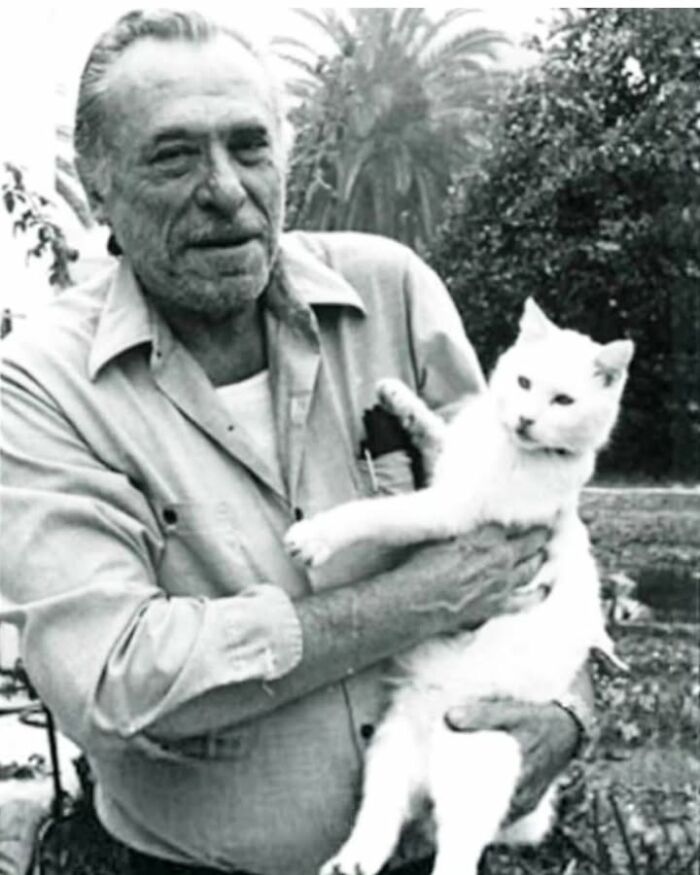
Image source: petshistorical
#52
American sailors, survivors of the perilous Arctic Convoy QP 14, gather with their mascot, Lassie, at Scapa Flow, Scotland, after returning from Arkhangelsk, Russia. Photograph taken on the 24 September 1942.
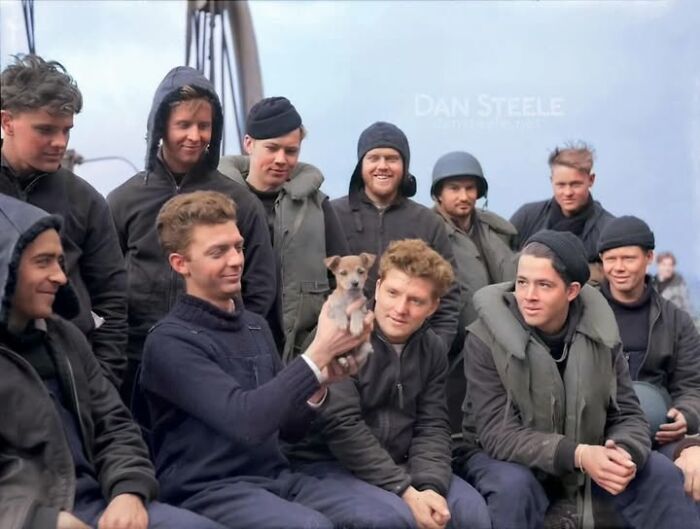
Image source: petshistorical
#53
“Galeana loves boxes, it’s just part of her personality.”
The Utah-based pet cat was rescued by an Amazon worker nearly a week after jumping into one of her family’s packages undetected.
She was accidentally mailed more than 1,000 miles to California with no access to food or water.
Luckily, Galeana had a microchip that was scanned by a vet, which allowed her to be reunited with her owners.
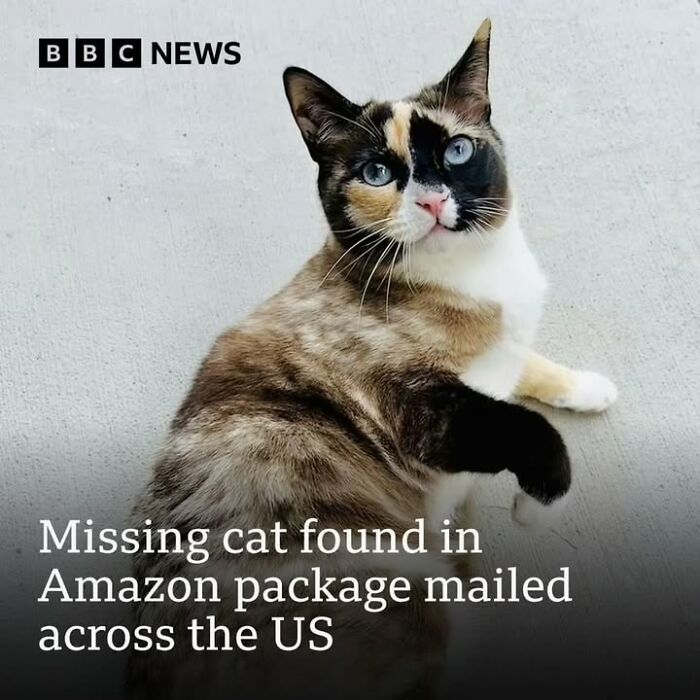
Image source: petshistorical
#54
He’s lived through two world wars, eight British monarchs and 40 U.S. presidents. His lifetime has seen the first phone call (1876), the first skyscraper (1885), the first power-driven flight (1903), the first people to walk on the moon (1969).
He was alive when the first photograph of a person was taken (1838); now he poses for selfies with adoring tourists. He was born before the creation of the postage stamp (1840), and now appears on them.
This happened a few days ago (Dec 4th)
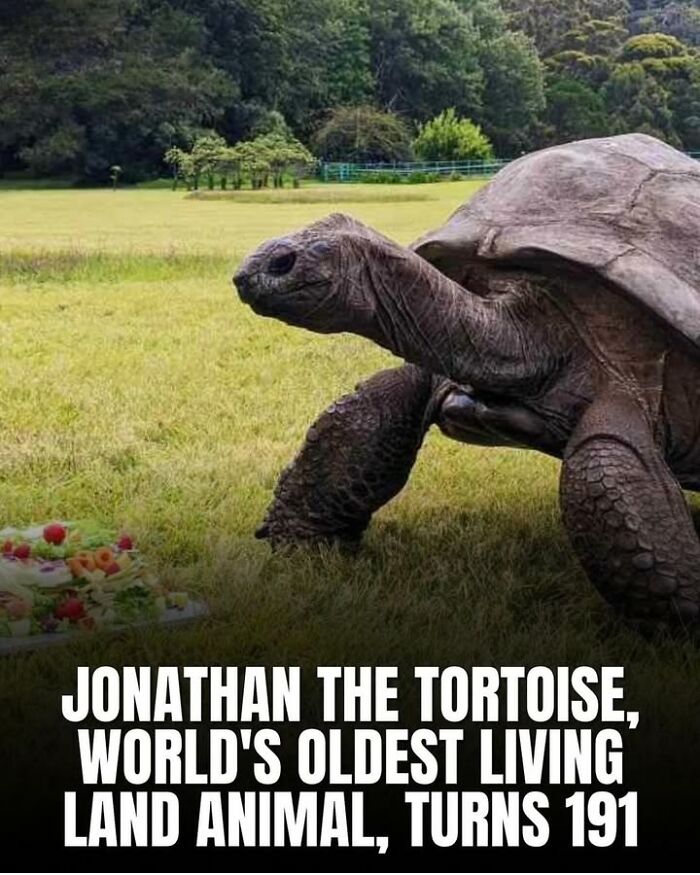
Image source: petshistorical
#55
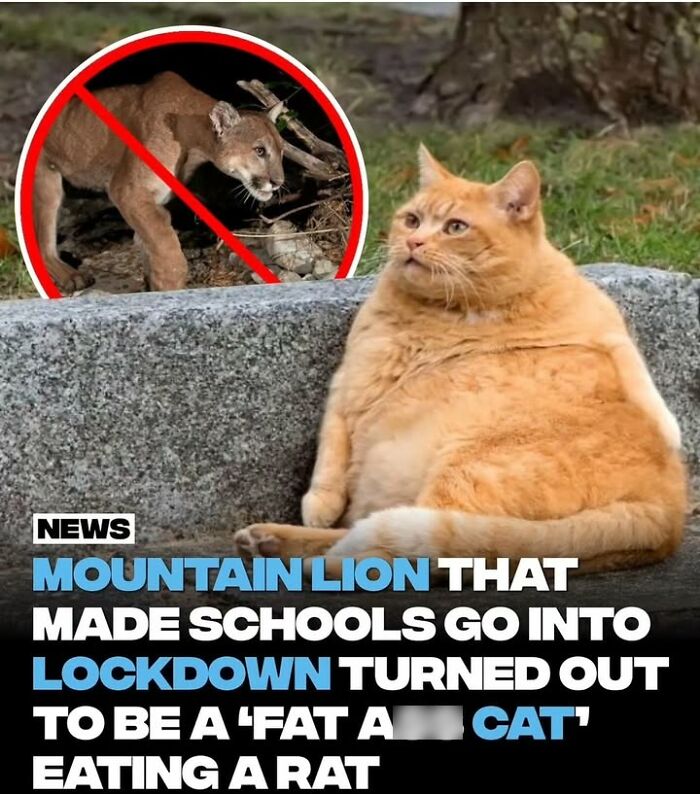
Image source: petshistorical
#56
The Church of St Peter in Wormleighton, England, was established in the early 12th century, with surviving nave angles indicating its Norman origins. By the century’s end, narrow aisles with three-bay arcades were added, and the west tower was constructed. The church, made of local ironstone, was valued at £10 in 1291.
In the 13th century, a chancel was added, followed by 14th-century aisle window alterations and a porch. The Spencer family, who owned the nearby manor, influenced the church’s upkeep. Medieval tiles in the nave, some with cat paw prints, reflect its historical charm.

Image source: petshistorical
#57
A pilot who flew more than 100 shelter animals out of areas impacted by Hurricanes Milton and Helene has adopted one of the kittens, making it the first adoption out of the group.
Southwest Airlines Captain Matt Prebish piloted the emergency flight on Oct. 12, airlifting 145 cats and dogs from animal shelters in Tennessee and Florida. They are now up for adoption in eight shelters.
After the flight, Prebish said he noticed one cuddly kitten who caught his eye: Avery, who now joins the captain’s family at home in Texas.
Prebish said he hopes Avery’s adoption story will inspire others to help those impacted by Hurricanes Milton and Helene.
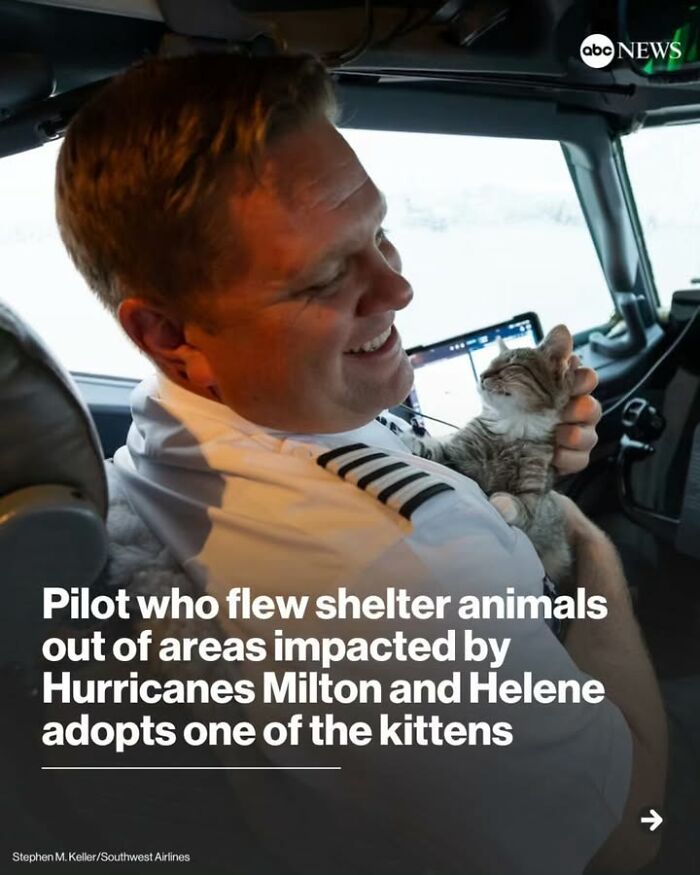
Image source: petshistorical
#58
Mercy Dogs: Meet the Heroes Who Delivered Aid and Comforted the Dying on the Battlefields of World War I
Over 16 million total animals were in service during the Great War.
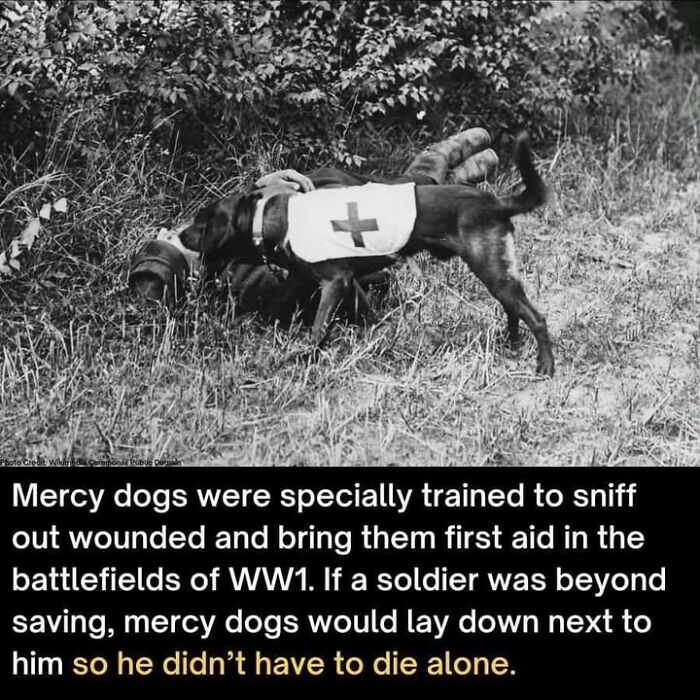
Image source: petshistorical
#59
During World War I, mercy dogs, or ambulance dogs, were trained to locate wounded soldiers on battlefields. They carried supplies like bandages or water for soldiers to treat minor injuries. For those too badly hurt to survive, the dogs stayed with them, providing comfort until the end. Their loyalty and instincts were crucial in the war.
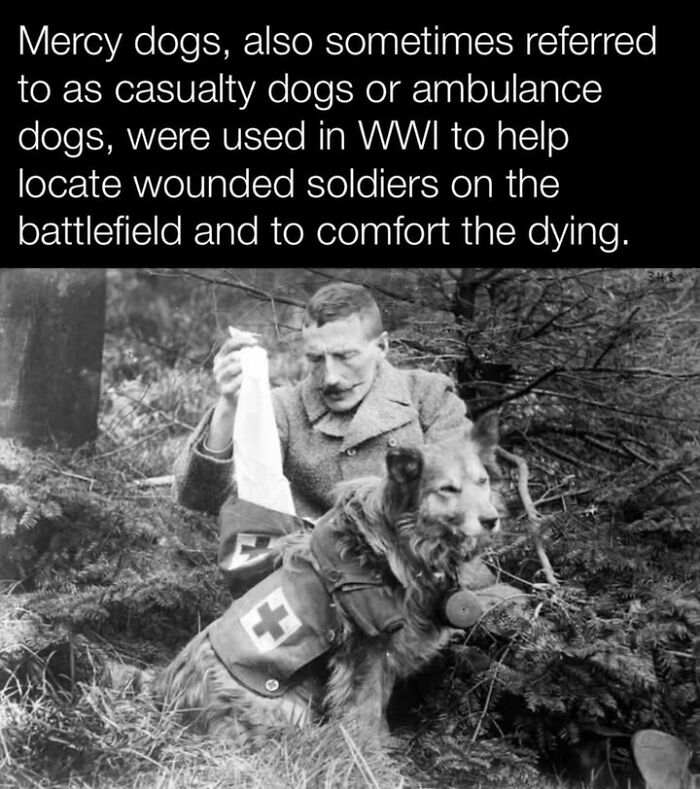
Image source: petshistorical
#60
This is Mike the cat, who assisted in keeping the Main Gate at the @britishmuseum Feb 1909 to Jan 1929. When he died, the former Keeper of Egyptian and Assyrian Antiquities, Sir E A Wallis Budge, wrote a pamphlet about him. His obituary was featured in both the London Evening Standard and Time magazine! In 1979, to mark the Golden Jubilee of his death, another pamphlet with illustrations was produced.
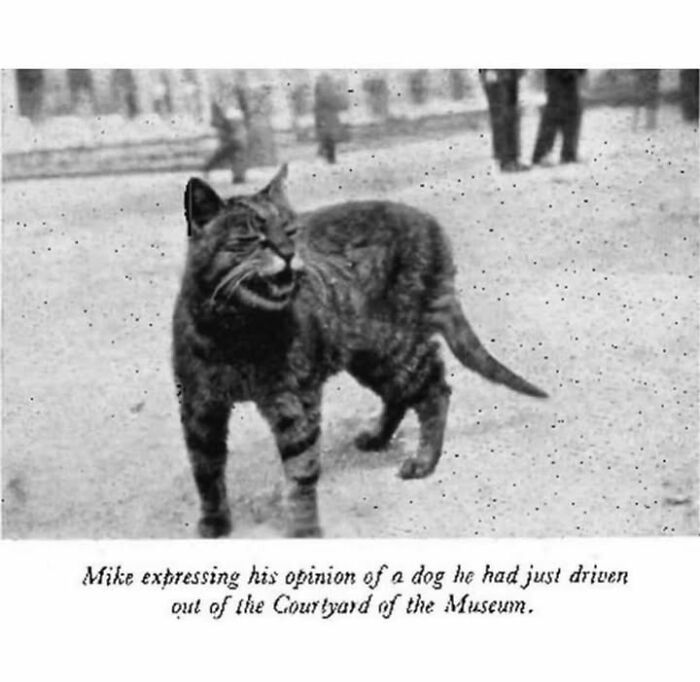
Image source: petshistorical
#61
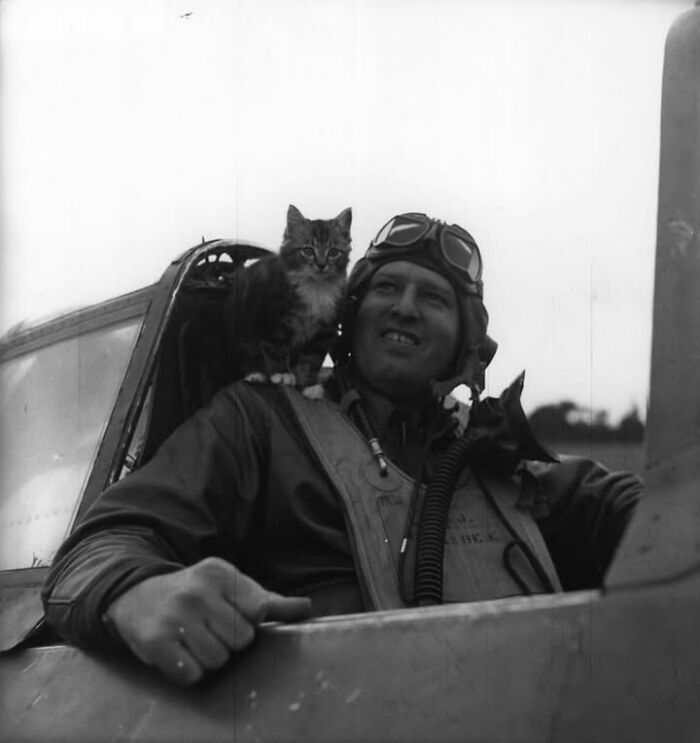
Image source: petshistorical
#62
Touched by its suffering, a soldier hoisted the weak donkey onto his back and brought it to safety. The troops cared for it, feeding and tending to it until it regained its strength. The donkey, affectionately named Bambi, became a cherished member of the group. More than a mascot, Bambi represented kindness and friendship in the midst of war’s cruelty.
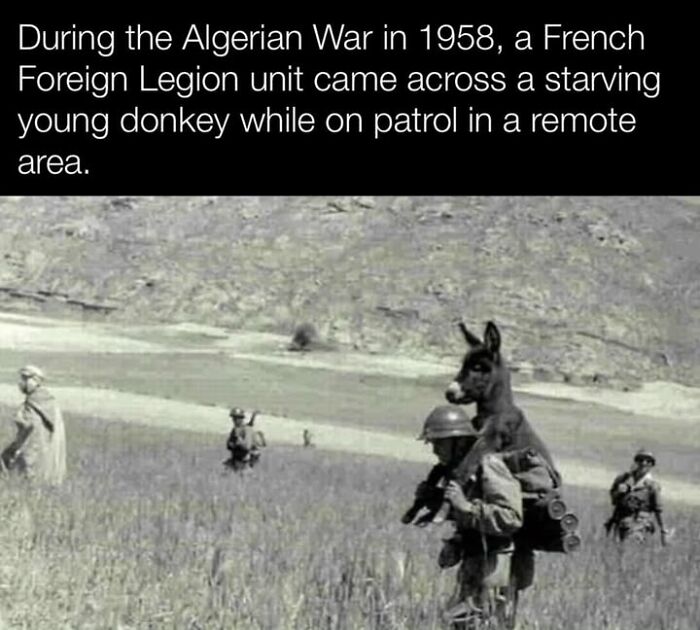
Image source: petshistorical
#63
Launched on February 26, 2024 the initiative aims to rescue, treat, and rehabilitate endangered, injured, threatened or abused animals worldwide, as well as restoring vital habitats.

Image source: petshistorical
#64
Who’s a good boy? Hachiko certainly was.
The legendary story of this devoted Japanese dog, who waited for his owner at a train station long after the owner’s death, continues to inspire people across the world.
Now, newly unearthed photos of Hachiko have been found.
One image shows Hachiko standing proudly by his own statue outside Tokyo’s Shibuya Station. Another captures the heartwarming moment where Hachiko lifts his paw to a station worker.
So far, around 80 confirmed photos of Hachiko have been discovered, as reported by the Shibuya Folk and Literary Shirane Memorial Museum.
📸: Shibuya Folk and Literary Shirane Memorial Museum, Kenichi Oshima
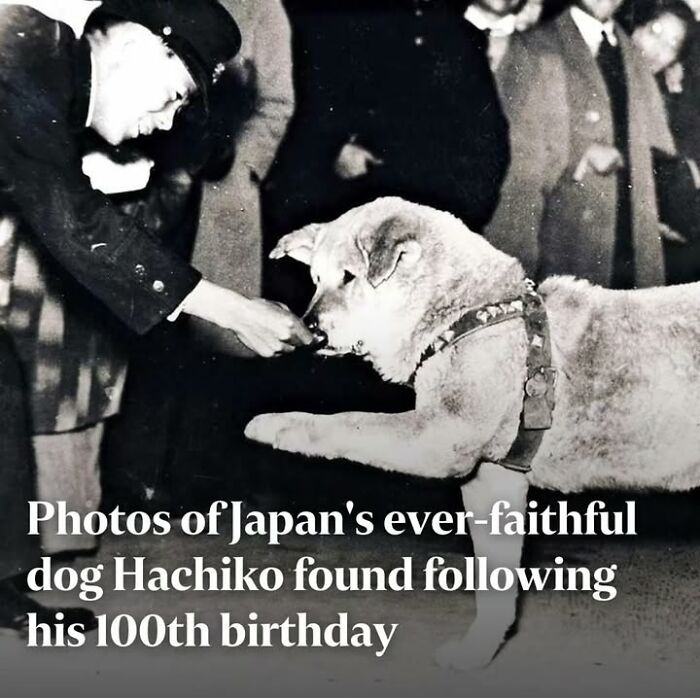
Image source: petshistorical
#65
In the Winter of 1943, in a photo booth in NYC’s Grand Central Station, a dapper man took several pictures of himself and his handsome German Shepherd dog. Here are a few of my favorites!
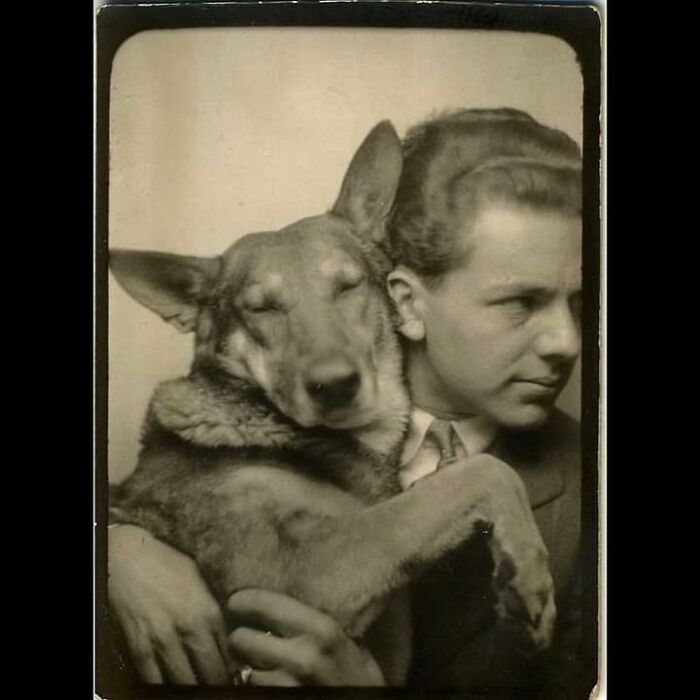
Image source: petshistorical
#66
George (died 29 April 2007) was a pet dog in Taranaki, New Zealand who was credited with sacrificing his life to save local children from a dog attack. George’s heroism was internationally recognized, and he received posthumous awards from New Zealand and British animal charities.
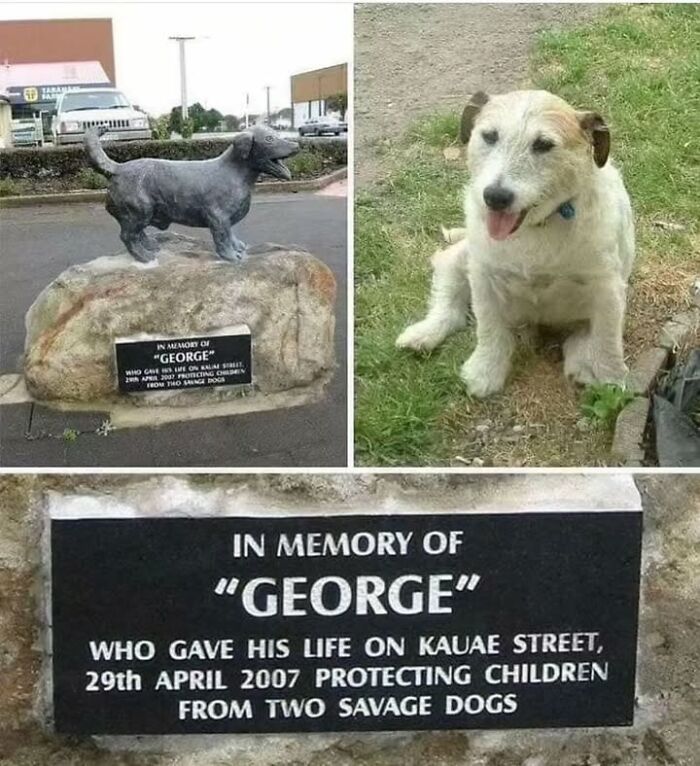
Image source: petshistorical
#67
Florence Nightingale and Alan Turing have statues dedicated to them. Now, so does Pebbles the cat.
He is much loved by students at the University of Essex and is often found wandering around the campus.
He’s so popular the university has even declared a Campus Cat Day and on social media his motto is listed as “If I fit, I sit”.
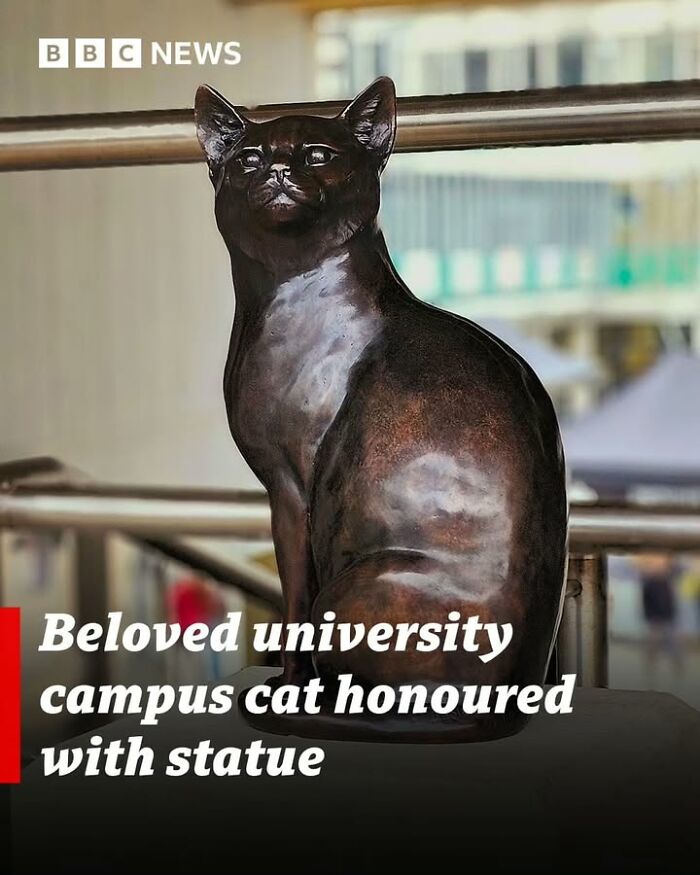
Image source: petshistorical
#68
Actress Wanda Hendrix Visiting Mildred Alexander’s Motel for Cats in San Francisco, 1947.
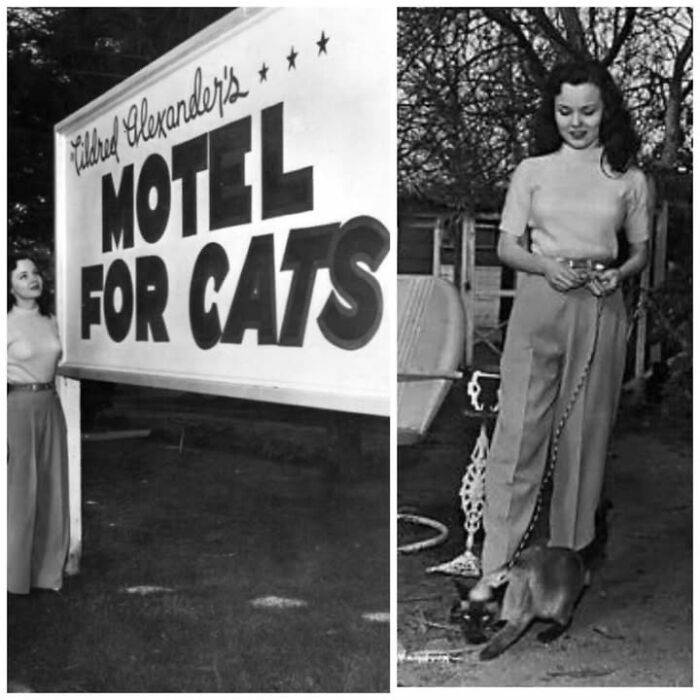
Image source: petshistorical
#69
Is it a bird? Is it a plane? It’s just Taters! 🐈
No, it’s an ultra high-definition video of a cat from the depths of space.
A 15-second clip of Taters the cat travelled 19 million miles – some 80 times the distance from Earth to the Moon via laser.
It was uploaded to a spacecraft launched with SpaceX’s Falcon Heavy rocket from Florida’s Kennedy Space Center on 13 October, and eventually streamed on 11 December.
“Despite transmitting from millions of miles away, it was able to send the video faster than most broadband internet connections,” said JPL electronics lead Ryan Rogalin.
Taters, whose paws remained firmly on Earth, is owned by a Nasa employee.
“Everyone loves Taters,” Rogalin added.
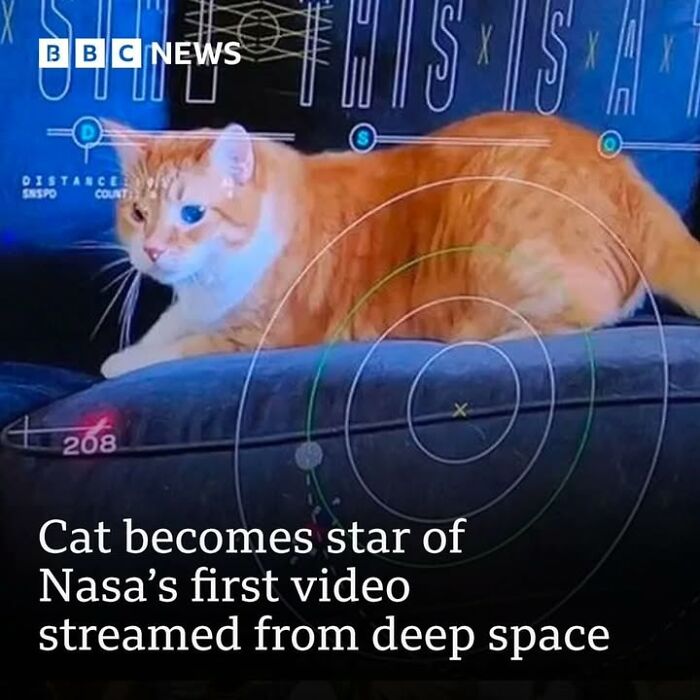
Image source: petshistorical
#70
Dodie Smith, the author of “The Hundred and One Dalmatians,” with her first Dalmatian Pongo in 1934.
In a 1957 letter to Walt Disney, Dodie thanked him for turning the book into a film, writing ‘I always hoped you might—so much so that, when I was writing it, I often found myself visualising the scenes as they would be in cartoon.’
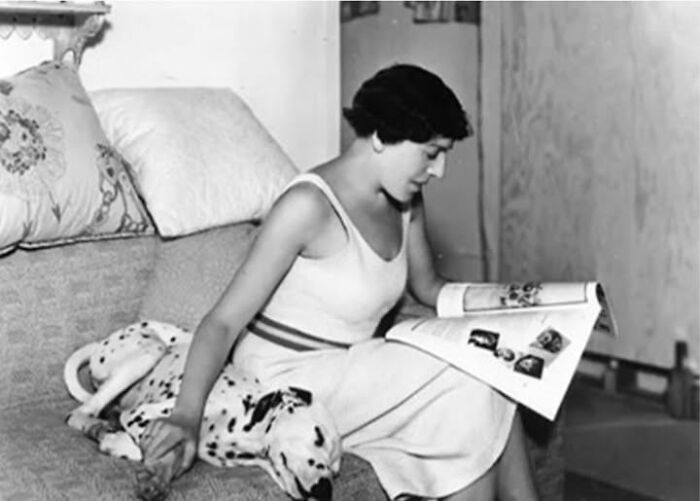
Image source: petshistorical
#71
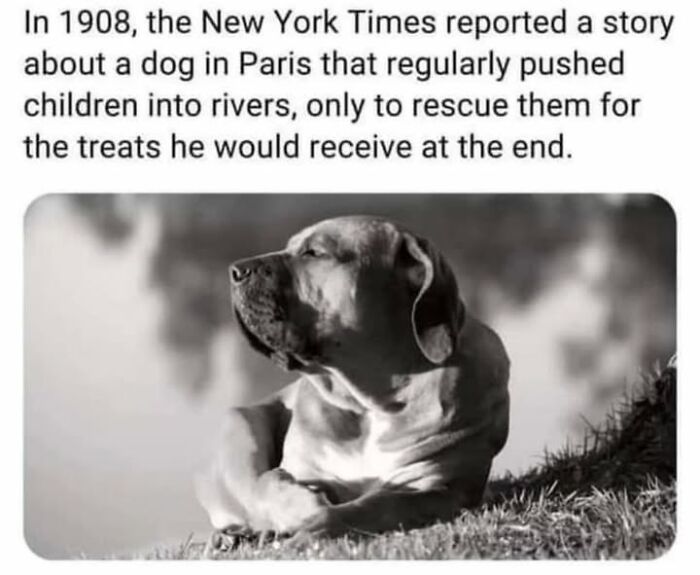
Image source: petshistorical
#72
Some of the Queen’s Corgis disembarking her private jet, 1998
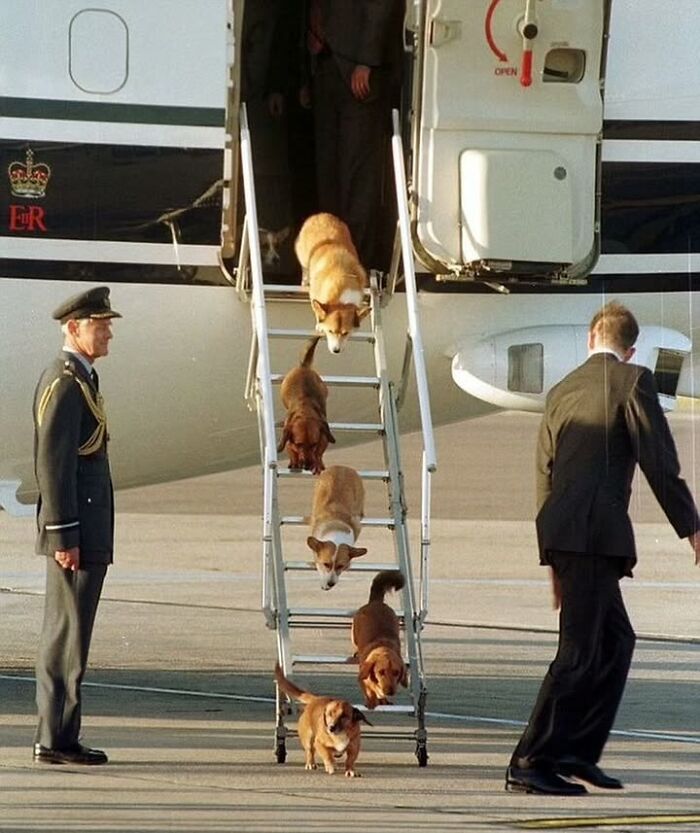
Image source: petshistorical
#73
In January 2007, Russian President Vladimir Putin brought his Labrador retriever into a meeting with German Chancellor Angela Merkel, who has a fear of dogs.
The incident sparked discussions about power dynamics and psychological tactics in diplomatic interactions. However, Putin later claimed he was not aware of Merkel’s fear of dogs at the time.
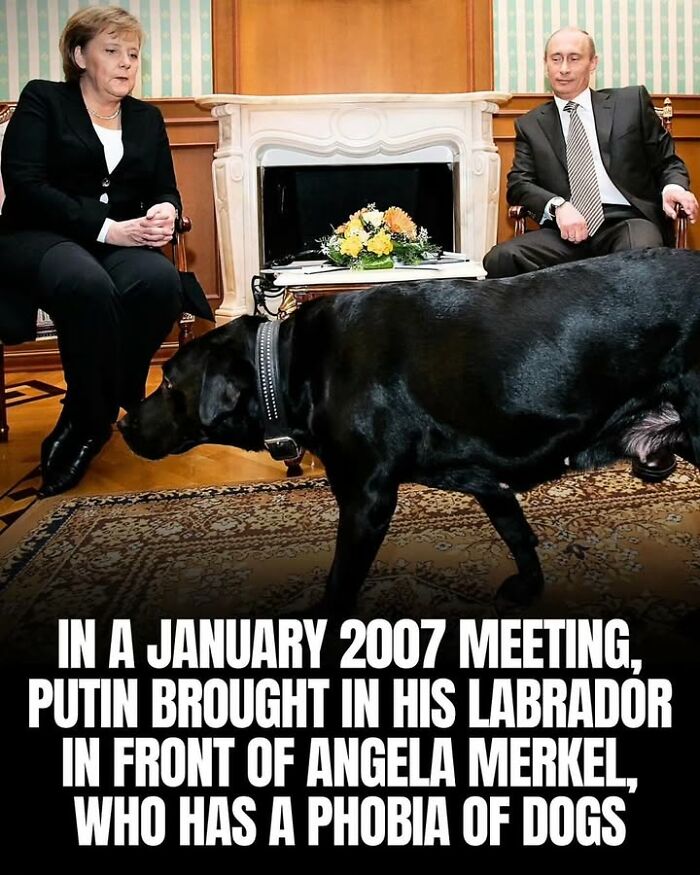
Image source: petshistorical
#74
During World War II, November 1943, Berlin Zoo faced heavy bombing by Allied forces. The attacks resulted in significant casualties among the zoo’s animal population. The zookeepers witnessed scenes of destruction and loss as a substantial portion, estimated around 30%, of the zoo’s animals perished during the bombings.
The following day, the suffering continued as the beloved aquarium, known for housing various marine species and being a popular tourist attraction, was destroyed, reduced to rubble in the bombings.
Amidst the chaos, zookeepers risked their lives to rescue and care for the remaining animals. They worked tirelessly to create makeshift shelters promptly, providing the surviving animals with necessary care and protection despite the ongoing turmoil and danger posed by the bombings. The dedication and efforts of the keepers were crucial in trying to safeguard the remaining animals during this challenging and tragic period in Berlin’s history.
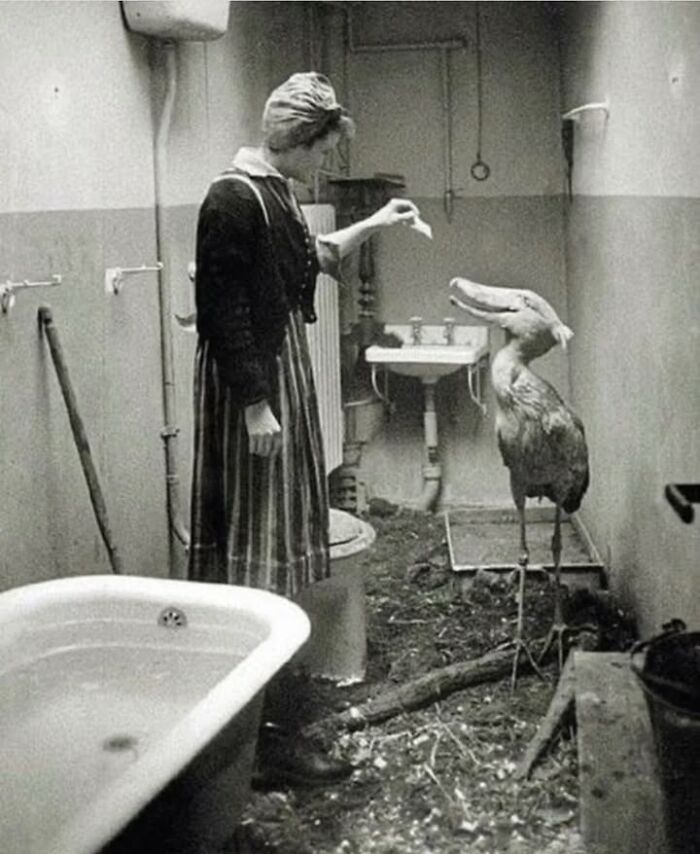
Image source: petshistorical
#75
A family in Pennsylvania was reunited with their pig named Kevin Bacon thanks to the actor, Kevin Bacon himself. 🐖
The adventurous pig had gone missing from his home for two weeks, causing distress to his owners.
After actor Kevin Bacon heard about the story, he shared it on his social media captioning it ‘Bring Kevin Bacon Home.’ 🏡
Ultimately, the pig was safely captured using a sticky bun laced with a pet-safe sedative
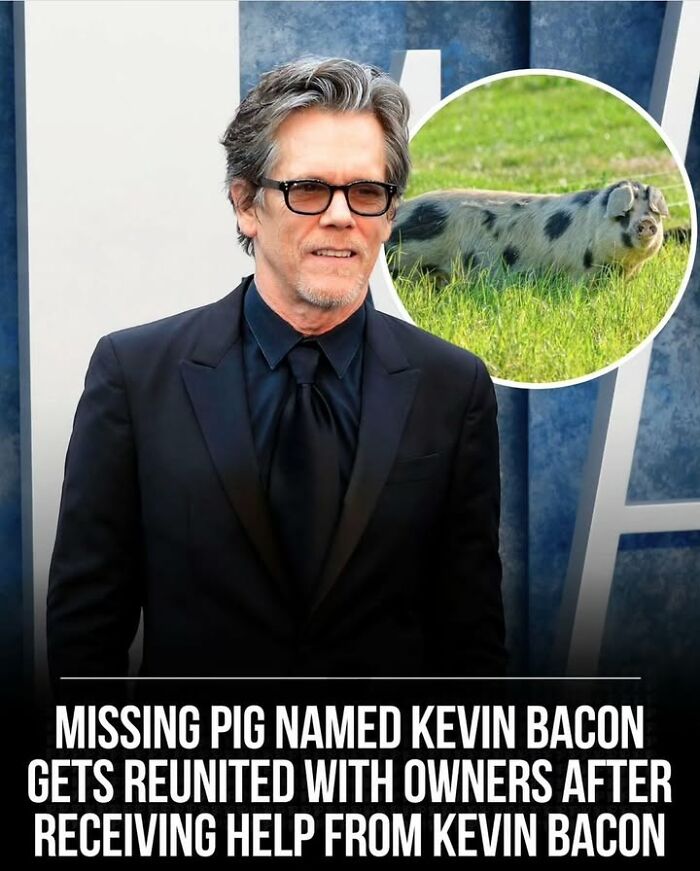
Image source: petshistorical
#76
President Gerald Ford cleverly used his Golden Retriever, Liberty, to politely end Oval Office meetings. When Ford wanted to wrap things up, he’d subtly signal Liberty, who would then happily approach the guest, wagging her tail. This created a natural break, letting Ford stand and signal the meeting was over without being abrupt. Liberty, a cherished part of the Ford family, was often seen with the president and even had puppies in the White House.
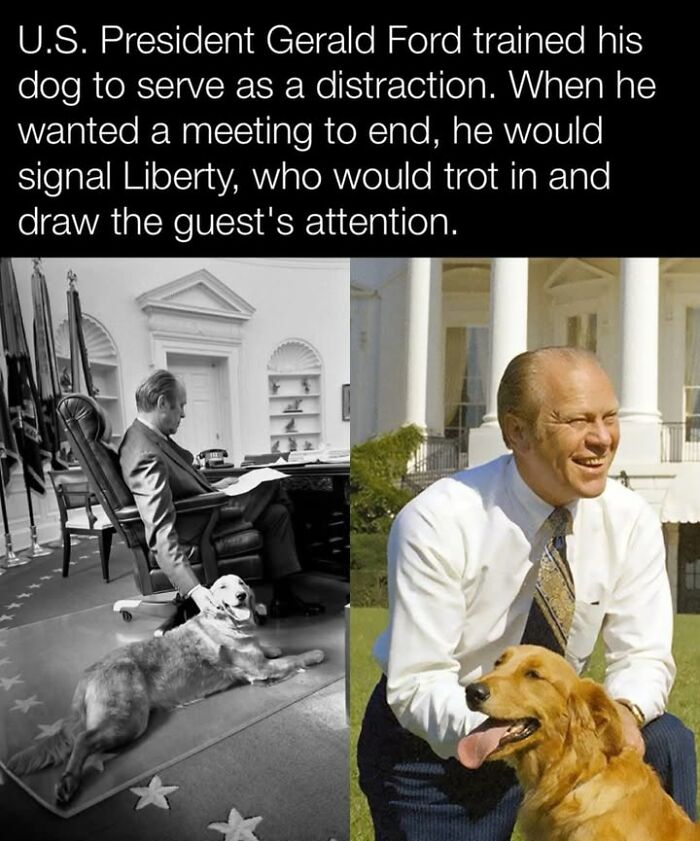
Image source: petshistorical
#77
Behind the scenes of Lady and the Tramp (1955)
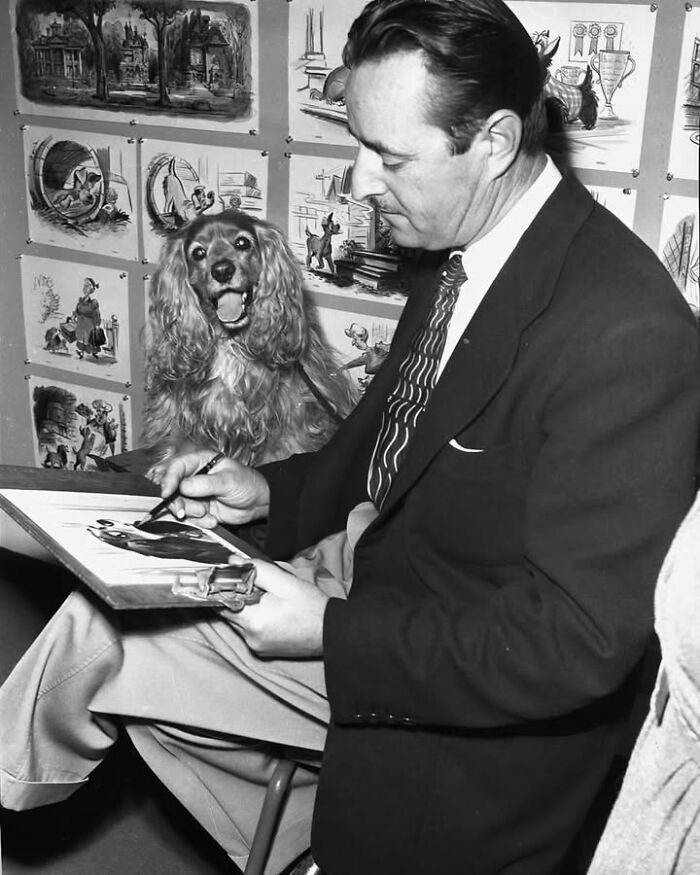
Image source: petshistorical
#78
A wealthy woman in Shanghai, China, has decided to bequeath her $2.8 million fortune to her pets, completely excluding her three children from the inheritance. 🐶🐱💰
The woman, surnamed Liu, reportedly felt neglected by her children in her old age and decided to leave everything to her loyal cats and dogs who stayed by her side.
Chinese online reactions varied, with some supporting her decision, citing similar intentions for their own assets. As it’s not legally possible to leave money directly to animals in China, a local veterinary clinic will manage the inheritance for the pets.
The woman’s will specifies that the funds must be spent on her pets and their offspring after her passing. Despite concerns about the risks, the China Will Registration Centre suggested that Liu could modify her will if her children’s attitudes change in the future.
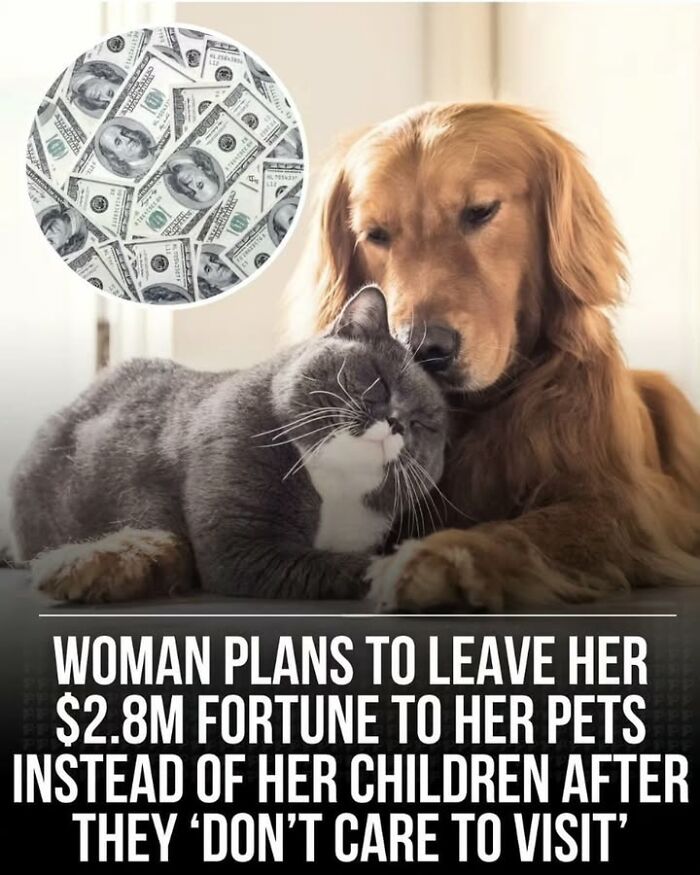
Image source: petshistorical
#79
Residents in several places in Germany are being hit with bills of up to €10,000 (£8,540) after the raccoons – which have also been spotted swigging beer – broke into their homes.
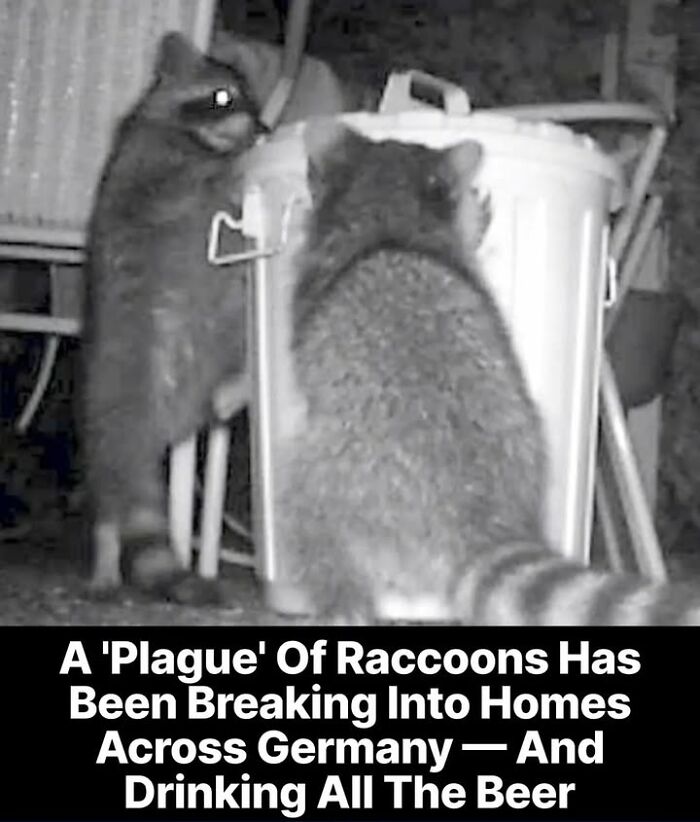
Image source: petshistorical
#80
A cat who helps women who have been trafficked is a finalist in this year’s National Cat Awards.
The event, organised by charity Cats Protection, highlights the “incredible bond” between cats and people.
Black and white Marley lives at Caritas Bakhita House, a safehouse in London for women who have been enslaved, exploited and trafficked.
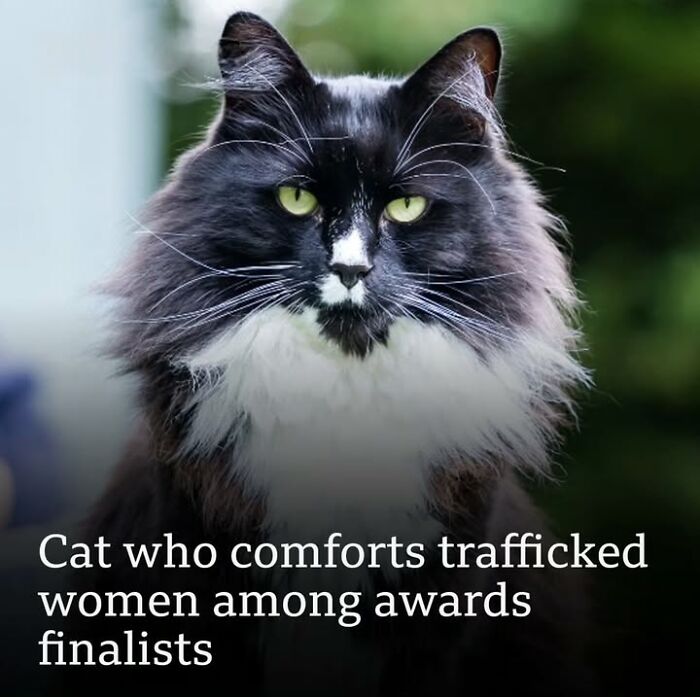
Image source: petshistorical
#81
Austrian artist Gustav Klimt adored his cat, Katze, and was famously photographed holding him in his arms in 1912.

Image source: petshistorical
#82
Mary Queen of Scots, imprisoned in England for nearly 19 years from 1568 to 1587, faced confinement under Elizabeth I’s orders after fleeing Scotland amid political turmoil. Held in various castles, including Carlisle, Bolton, Tutbury, and Fotheringhay, her captivity ranged from relative comfort to strict isolation, always under guard to prevent escape or rebellion. Despite her royal status, Mary’s life was marked by limited freedom, constant surveillance, and deteriorating health, yet she maintained her claim to the English throne, fueling Catholic plots like the Babington Plot, which ultimately led to her execution.
Engaging in needlework, letter-writing, and secret communications with supporters, Mary remained a resilient, defiant figure, her imprisonment a complex interplay of political threat and personal endurance, culminating in her tragic beheading for treason in 1587.
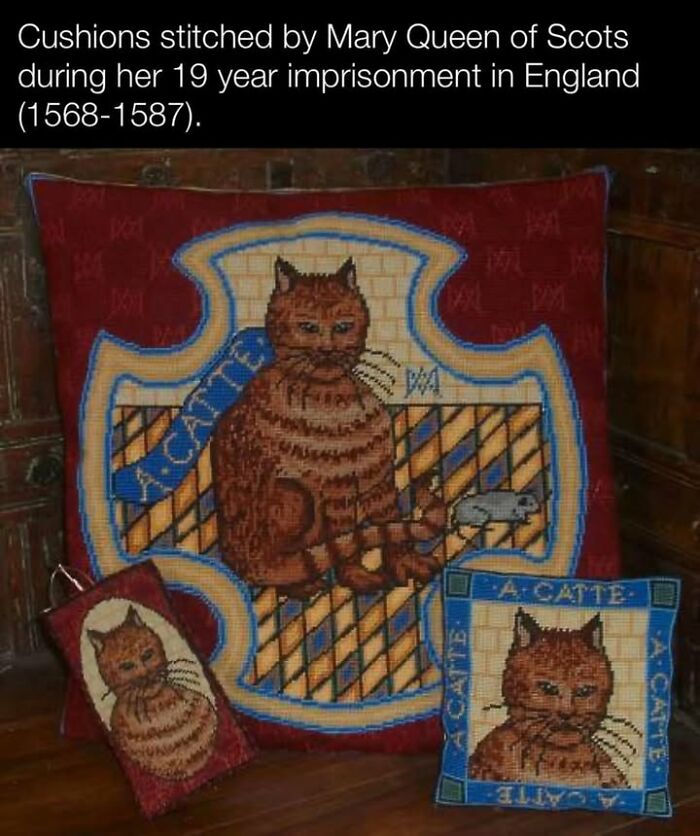
Image source: petshistorical
#83
For thousands of years, Romans crafted heartfelt epitaphs for their beloved dogs, inscribed on stone tablets. These farewell messages, dating back to the 1st century BCE, express deep affection and grief, often praising the dogs’ loyalty, playfulness, and companionship. Found in archaeological sites across the Roman Empire, these epitaphs reveal the enduring bond between humans and their canine friends.
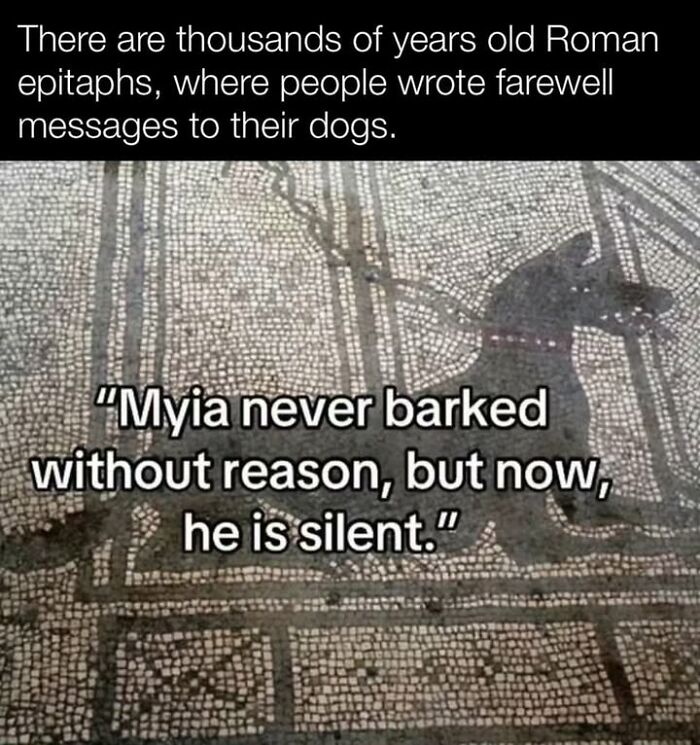
Image source: petshistorical
#84
In the 1870s, the city of Liège in Belgium conducted an unusual experiment involving cats as mail carriers.
As part of a test proposed by the Belgian Society for the Elevation of the Domestic Cat, 37 cats were trained to deliver messages in small waterproof bags attached to their necks. The cats were released in villages around Liège with the goal of returning home with the mail, similar to how carrier pigeons operated.
While some cats did successfully return—one in under five hours—the overall results were inconsistent, as the cats tended to follow their own whims rather than strict delivery routes.
Due to their unreliable nature, the experiment was never repeated.
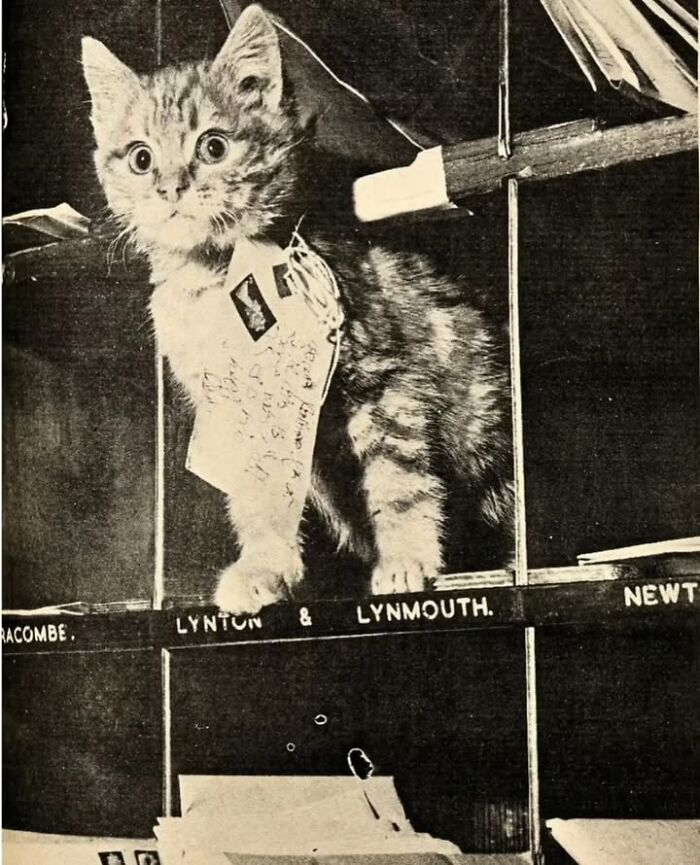
Image source: petshistorical
#85
Zhang Zhengyu (1904–1976) was a key figure in 20th-century Chinese art, celebrated for his mastery of calligraphy and traditional painting. Born in Wuxi, Jiangsu Province, he became one of the driving forces behind the revival of Chinese calligraphy, earning widespread respect for his elegant brushwork and dedication to preserving classical techniques.
But Zhang’s legacy wasn’t limited to characters and strokes — it also included cats.
Deeply fascinated by their elegance and emotion, Zhang often painted cats in calm, curious, or playful moods. His close observation of their movements and personalities gave his feline portraits a natural charm that felt almost lifelike. This passion earned him the affectionate nickname “Old Cat Master” among fellow artists.
Today, Zhang Zhengyu is remembered not just as a pioneer of Chinese calligraphy, but as an artist who brought grace, life, and a touch of whimsy into his work — one brushstroke (and one cat) at a time.
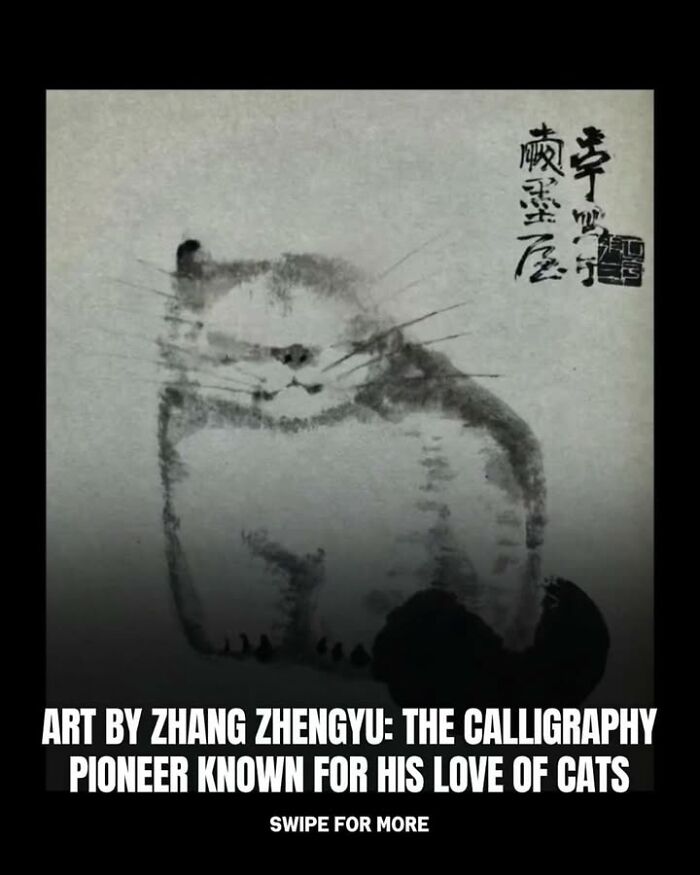
Image source: petshistorical
#86
Decoy, Shohei Ohtani’s dog, really just threw out the first pitch at Dodger Stadium.

Image source: petshistorical
#87
Good boy! 🐶
Cpl. Bradley Starling and K-9 Charlie were awarded Medals of Valor for their efforts in locating 3 missing children in Monroe County, Mississippi.
After receiving an article of clothing from one of the children, Charlie quickly picked up the scent and tracked for 200 yards, finding footprints.
Within 15 minutes, Charlie located all three children, who were safely returned home!
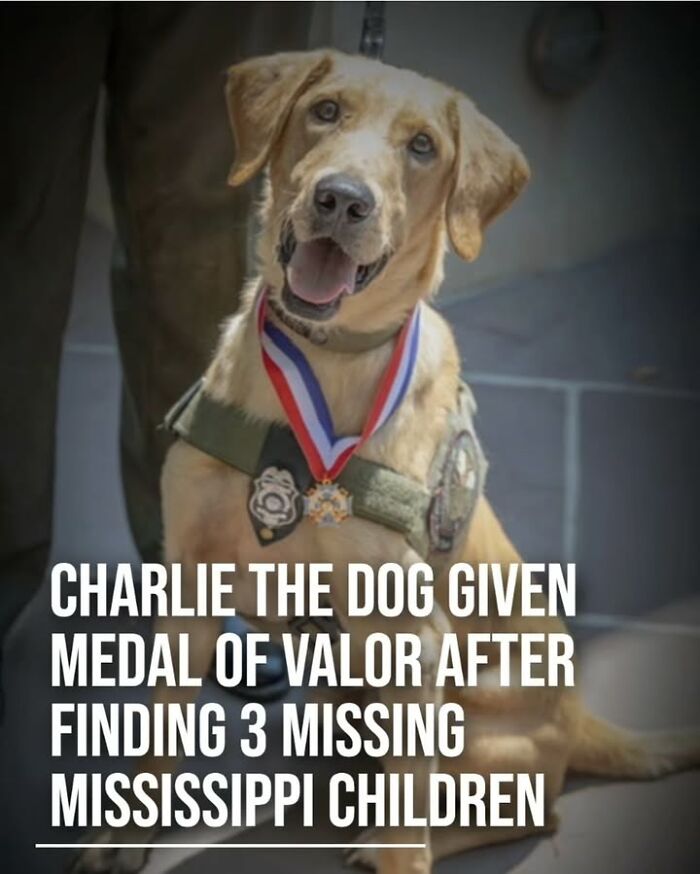
Image source: petshistorical
#88
Félicette was the first and only cat to travel to space.
She was part of a French space program in the early 1960s, chosen from a group of 14 stray cats for her calm nature and small size.
On October 18, 1963, she was launched aboard a Véronique AG1 rocket and reached an altitude of about 157 kilometers before safely returning to Earth by parachute. Throughout the flight, electrodes attached to her body transmitted neurological data, helping scientists better understand the effects of space travel, specifically the effects of low gravity.
Sadly, Félicette was later euthanized so researchers could study her brain in detail. For many years, her contribution was overlooked, but in 2019, a bronze statue at the Space University of France was finally erected to honor her legacy in space exploration.
When researching this story, I was elated that Félicette made it back alive, unlike Laika who never even had a chance. I was hoping she lived out the rest of her life in peace and comfort, but alas, my heart sank when I finished the rest of her story.
My cat freaks out at the slightest disturbance, so I can’t imagine how scared Félicette must have been on her journey to space. I’m just glad that no other cat shared her same fate.
Poor kitty, hope you’re resting in peace 💜
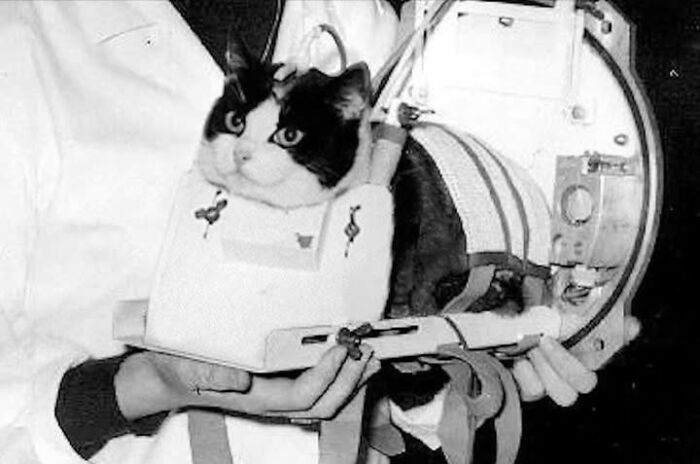
Image source: petshistorical
#89
The original caption to this 1956 Bettmann Archive image reads: “This feline version of Uncle Sam is all dressed up in patriotic attire for the Fourth of July. From the looks of things, the cat is declaring Independence Day for working felines. He’s a professional cat model and lives with his owner, Roslyn Stock, at 770 East Tremont Avenue in the Bronx.”
Happy 4th of July!! 🇺🇸
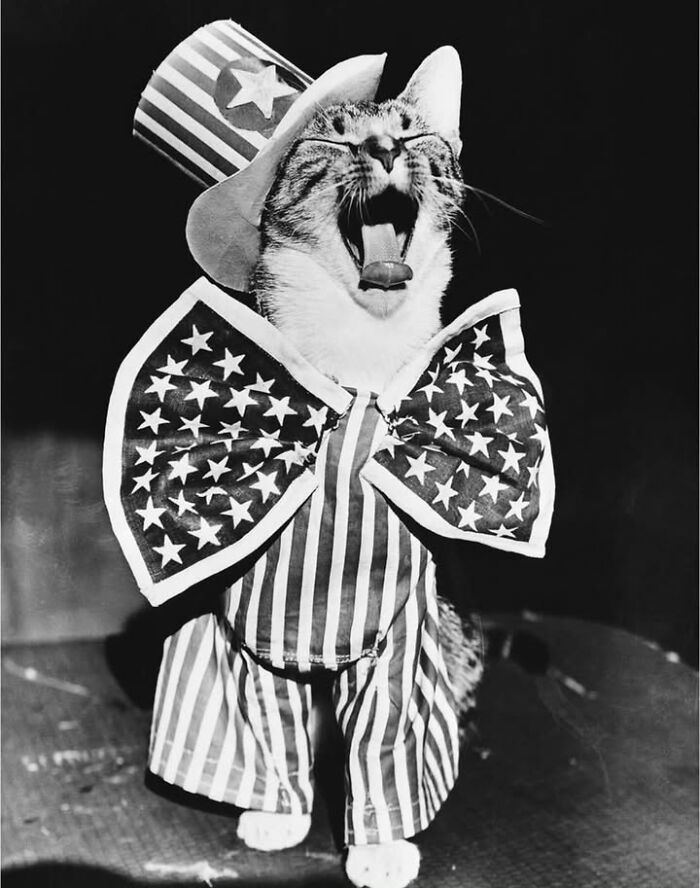
Image source: petshistorical
#90
During the rabbit hunt organized by Napoleon in July 1807, a mistake was made in selecting the rabbits. These rabbits were tame, used to being fed by a particular person daily. When released from their cages, hungry and expecting their usual meal, they mistook Napoleon and his companions for their feeder. Instead of fleeing, as wild rabbits typically would in such situations, these tame rabbits charged towards them, seeking food. There were hundreds, if not thousands of rabbits.
Despite the group’s attempts to shoo them away, the rabbits persisted, probably due to hunger and confusion. They nipped at their heels and surrounded them, overwhelming Napoleon and his men. It seemed the rabbits’ natural instinct to seek food from whoever released them caused the unusual attack, leading to the chaos and forcing Napoleon and his party to retreat.
(References:
Chandler, David. The Campaigns of Napoleon. Vol. 1. London: Weidenfeld & Nicolson, 1995.
Delderfield, R. F. Napoleon’s Marshals. New York: Cooper Square Press, 2002.)
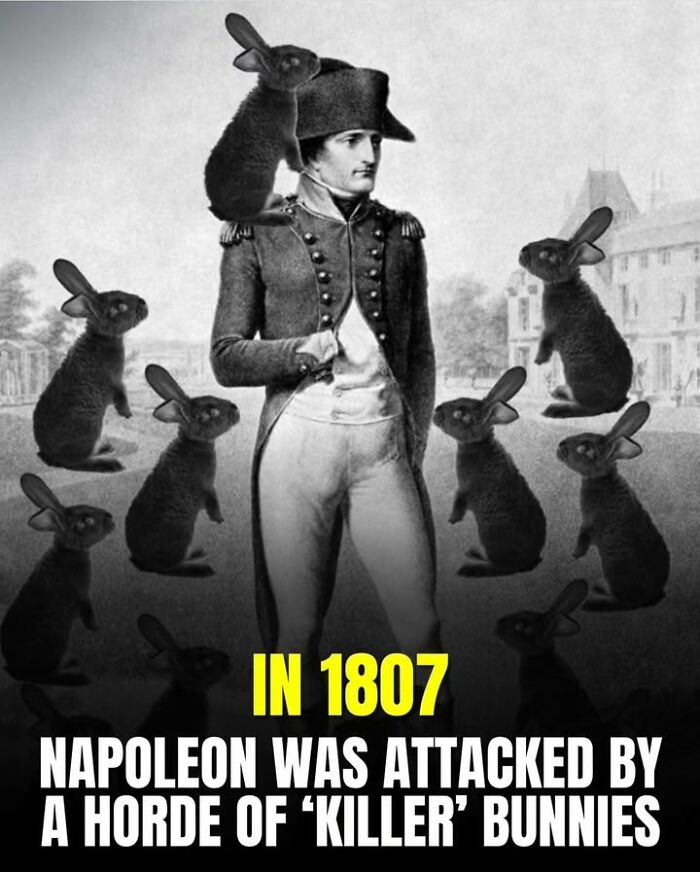
Image source: petshistorical
#91
In the summer of 1939, the British government began preparing for the outbreak of World War II. Part of that preparation involved the formation of the National Air Raid Precautions Animals Committee (NARPAC), a committee tasked with deciding how to handle pets once war commenced. The committee worried that due to inevitable war time food shortages, pet owners would either have to split their rations with their pets or leave the animals to starve. Their solution was to publish a pamphlet titled “Advice to Animal Owners.”
The pamphlet said: “If at all possible, send or take your household animals into the country in advance of an emergency.” It concluded: “If you cannot place them in the care of neighbours, it really is kindest to have them destroyed.” It also featured an advertisement for a pistol that could be used to humanely kill the animals.
The recommendation, printed in almost every newspaper and announced on the radio, spread throughout the country. After war was declared on September 3, 1939, pet owners flocked to clinics and animal homes to have their pets killed in preparation for food shortages.
Due to the mass hysteria, historians estimate that as many as 750,000 British pets were killed in just one week.
Animal charities and groups such as The People’s Dispensary for Sick Animals (PDSA) and The Royal Society for the Prevention of Cruelty to Animals (RSPCA) were against people taking such drastic measures. They cautioned pet owners against haste, yet anxious Britons still panicked.
When London was bombed in September 1940, even more pet owners rushed to kill their pets. PDSA founder Maria Dickin reported: “Our technical officers called upon to perform this unhappy duty will never forget the tragedy of those days.”
Many tried to help. Battersea Dogs and Cats Home managed to feed and care for 145,000 dogs during the course of the war. The Duchess of Hamilton, a wealthy cat lover, broadcast a message on the BBC and established an animal sanctuary.
When the war ended, many regretted the British pet massacre. They felt remorse but often blamed the government for starting the frenzy.
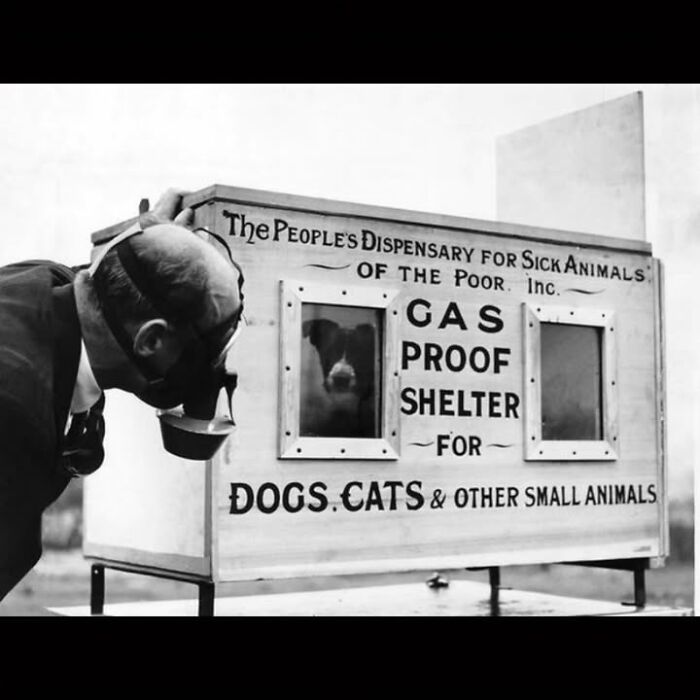
Image source: petshistorical
#92
Towser the Cat – The World’s Greatest Mouser 🐈⬛🏴
In the scenic town of Crieff, Perthshire, at the historic Glenturret Distillery, lived a cat who became a world record holder — and a legend in her own right.
Towser wasn’t just any distillery cat. She was a long-haired tortoiseshell with a job to do: keeping the grain stores free from mice. And over her 24-year career, she absolutely excelled at it.
From 1963 to 1987, Towser patrolled the malt barns and warehouses with feline precision. By the time she passed away, it was estimated that she had caught an astonishing 28,899 mice — an average of 3 mice a day. That feat earned her a Guinness World Record for the most mice caught by a single cat.
She became a local legend, a celebrity among distillery cats, and a symbol of dedication and hard work (with the occasional nap by the stills, of course). Towser even has her own statue outside the distillery and a commemorative plaque in her honour.
Today, while modern pest control has replaced the need for mousers, Towser’s legacy lives on — and she remains one of Scotland’s most iconic cats
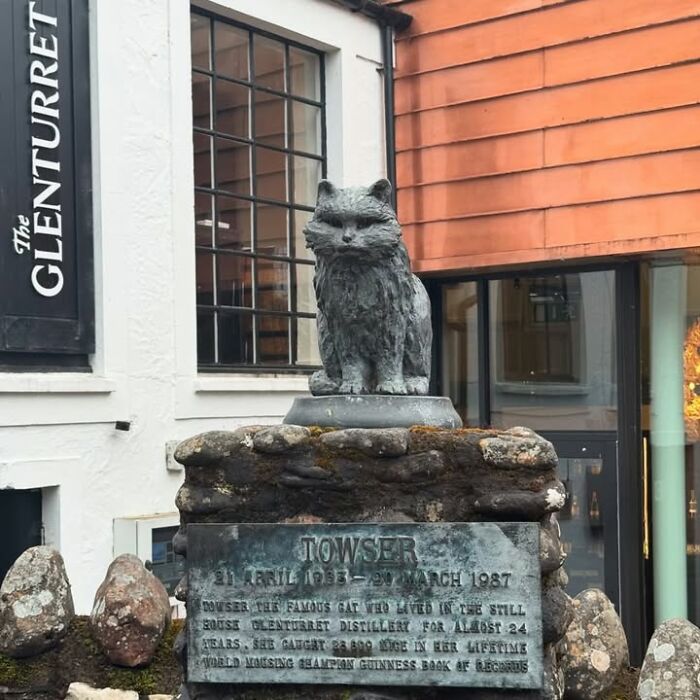
Image source: petshistorical
#93
At Comiskey Park‚ the Yanks are winning a laugher‚ 16-5‚ when a dog wanders onto left field in the 9th inning. Babe Ruth briefly plays with the pup‚ then tosses his mitt to chase it away. The dog promptly grabs the mitt and takes off at the same moment that Sox rookie pitcher Paul Castner lofts a fly to left. Babe casually catches the fly bare handed. August 20, 1923. The dogs name was Hazel
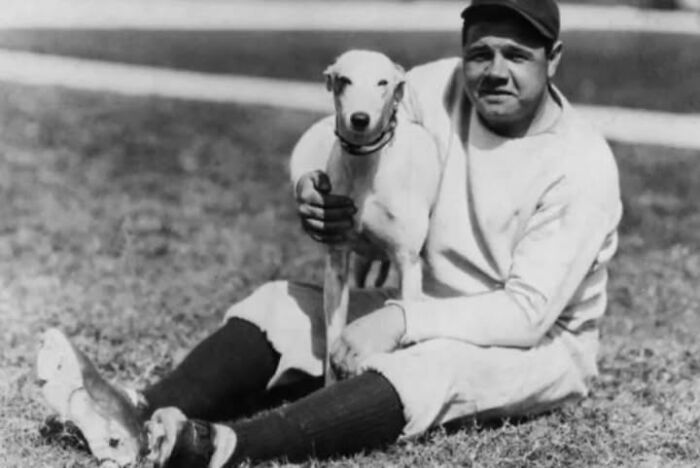
Image source: petshistorical
#94
Pigcasso, the wildly talented pig who sold over $1 million of her paintings and was hailed “the most successful non-human artist in world history,” has died at age 8.
Joanne Lefson, the creative critter’s owner, recently announced the 450-pound visionary’s death due chronic Rheumatoid arthritis. Prior to her passing, the pig’s illness rendered both of her back legs lame, owing to calcification of her lower spine.
“There is much sadness that such an inspiring figure for welfare animals has passed,” Lefson, 52, told Caters News. “But we also celebrate a life well-lived and the profound difference she made.”
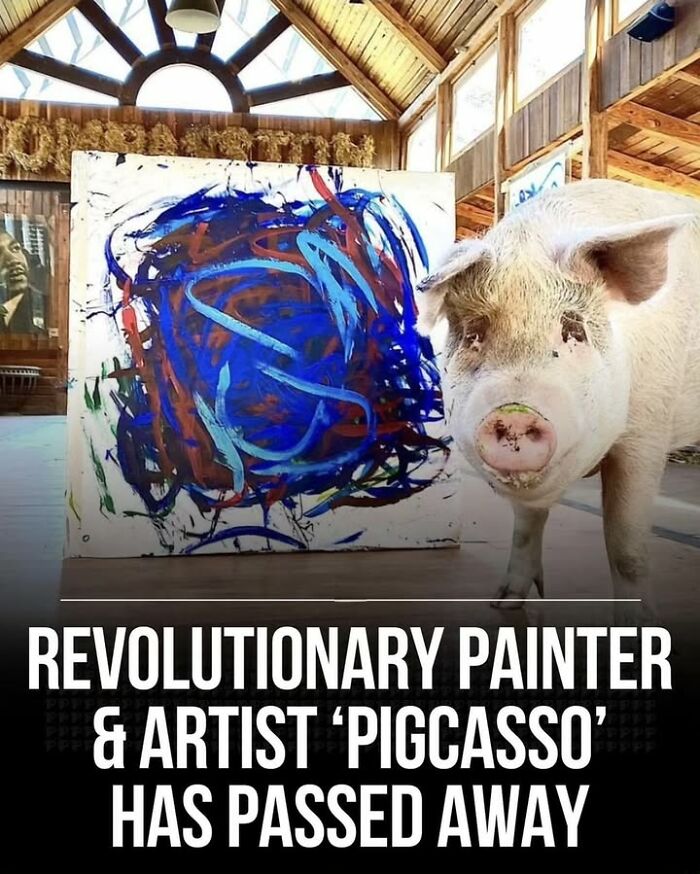
Image source: petshistorical
#95
In 1907, the ingenious Dr. Julius Neubronner of Germany unveiled his pigeon camera invention—a marvel that combined tiny cameras, pigeon bravado, and a touch of avian elegance. 🕊️📸 These feathered photographers sported strapped cameras equipped with timers, capturing the world from the skies as they soared.
Neubronner’s pigeon crew became pioneers in airborne photography, not just tracking their flights but creating postcard-worthy snapshots for sale (he actually sold some of them)
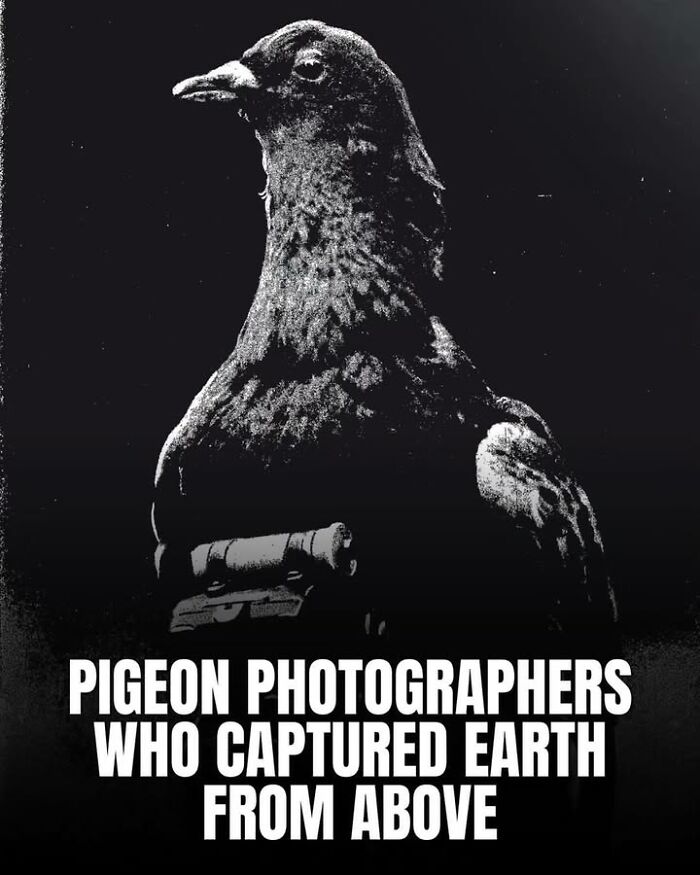
Image source: petshistorical
#96
650 officers and enlisted men of Auxiliary Remount Depot No. 326, Camp Cody, in a symbolic head pose of “The Devil” a saddle horse ridden by Maj. Frank G. Brewer. 1919.
A fitting tribute to the over 8 million horses, donkeys and mules who died during World War I.
Library of Congress Prints and Photographs Division.
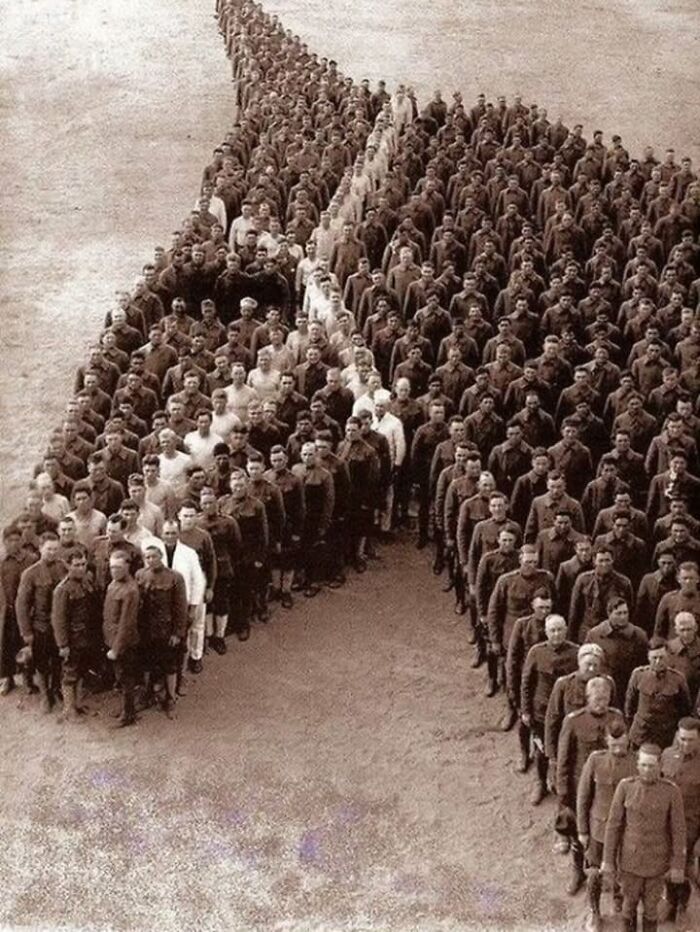
Image source: petshistorical
#97
In a forested corner of Central Park there lives a tree that, if you walk by at just the right time of the year, will reveal to you its secret identity as the Pet Memorial Christmas Tree.
The tree gleams with hundreds of laminated photos, notes, ornaments and memorials to deceased pets. There’s Milo, commemorated as “A Good Boy,” and the “Al Dente Brothers,” who are “forever loved.” There’s Sherman, the Eastern box turtle, Geo the fish and Miss Parker, the “fearless, independent, and amusing” Central Park squirrel.
Decorated every year by the “Keeper of the Tree” and other volunteers, the tree is a public expression of love on display between Thanksgiving and Three Kings Day in January. See the good boys and girls decorating this year’s tree by tapping the link in our bio.

Image source: petshistorical
 Follow Us
Follow Us





